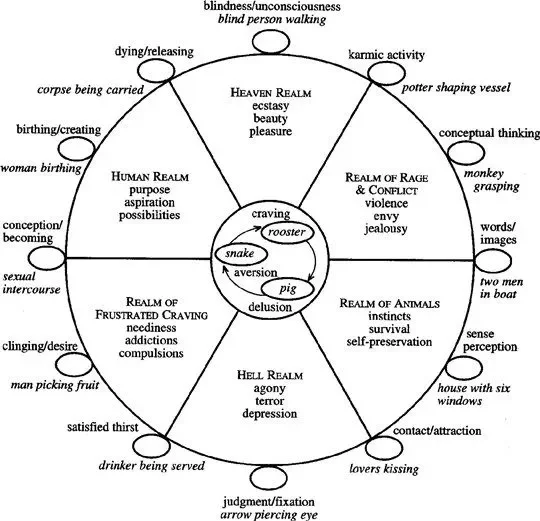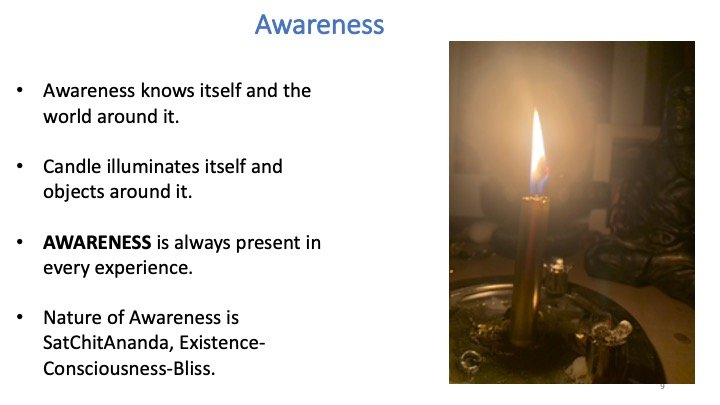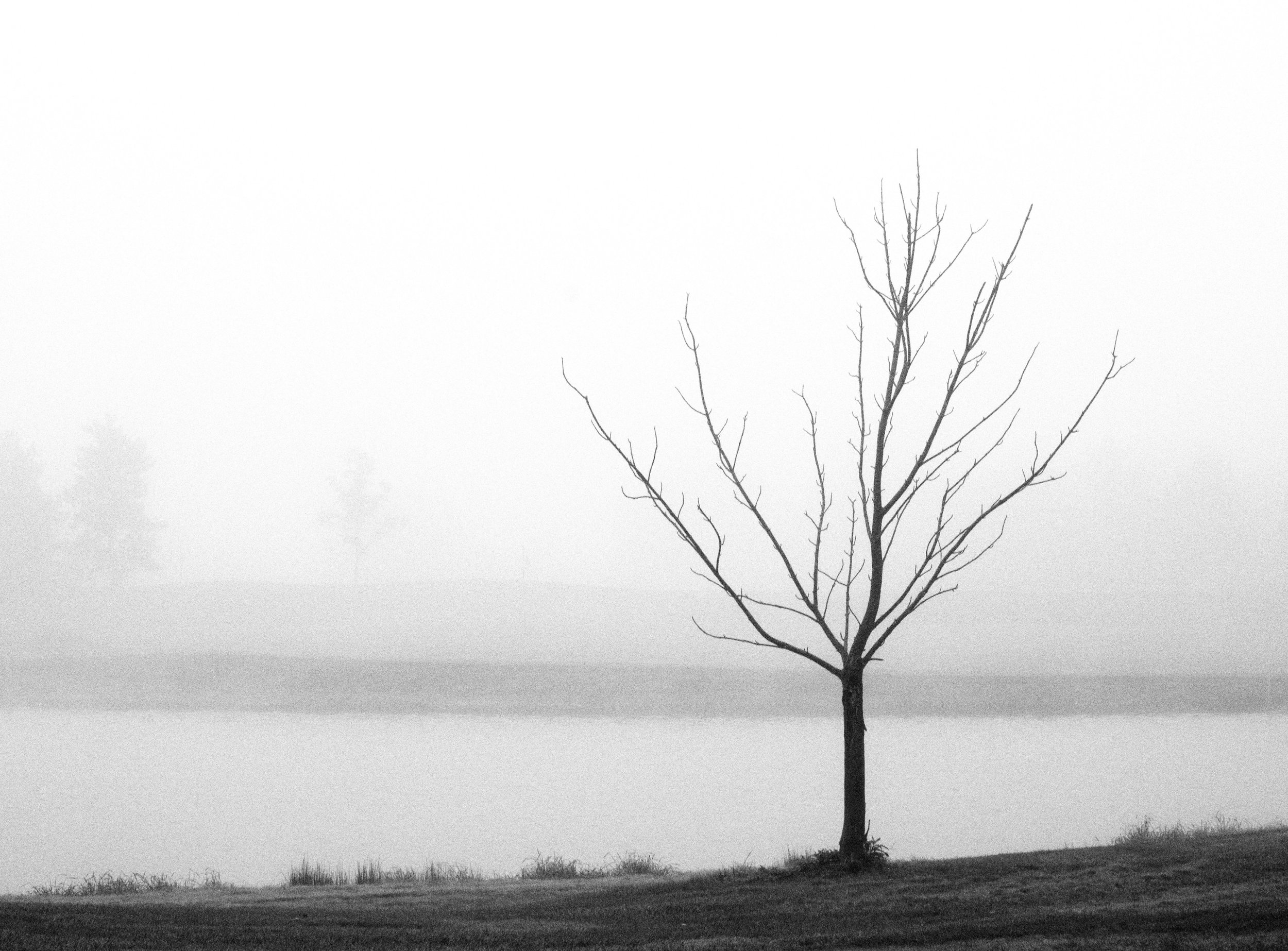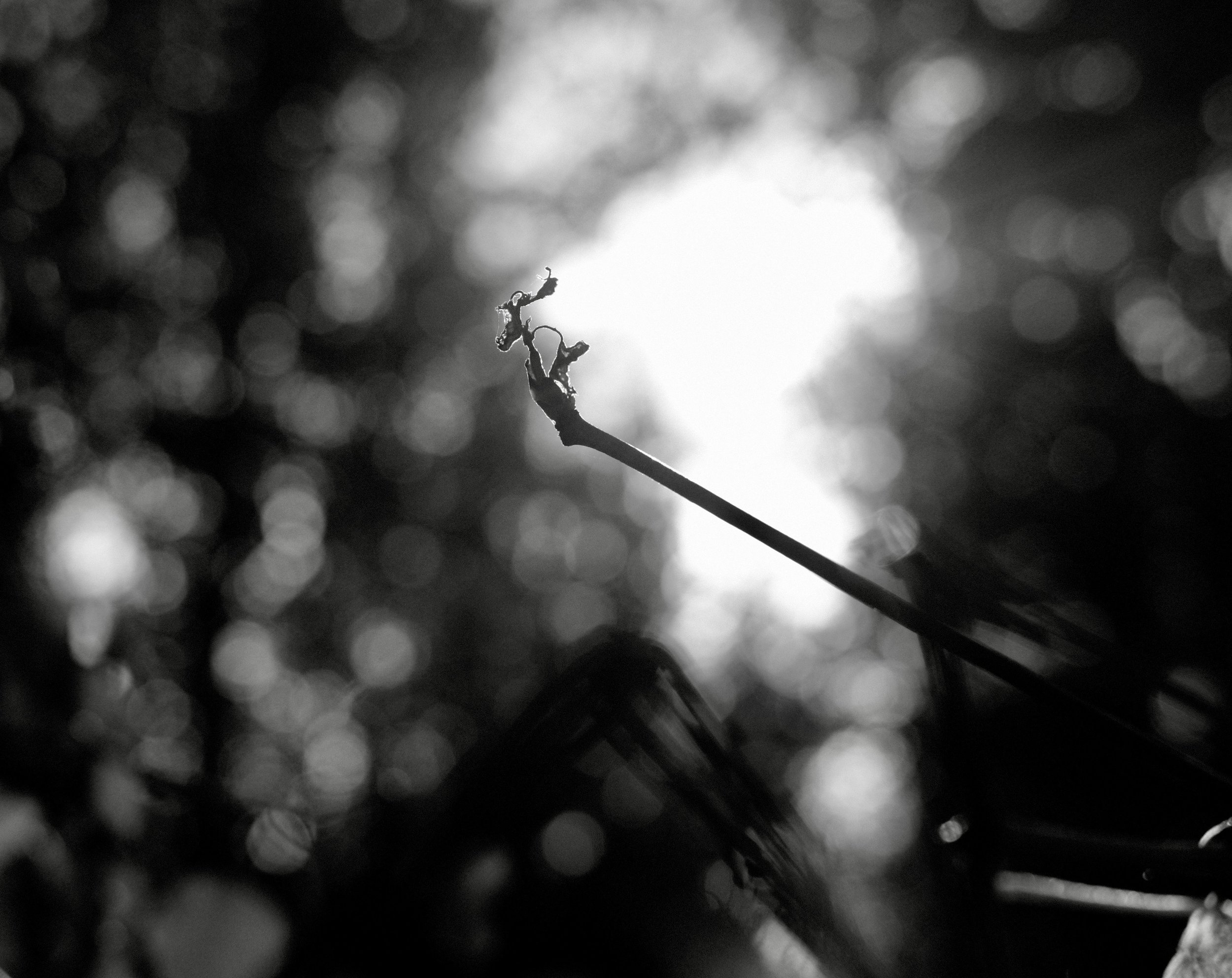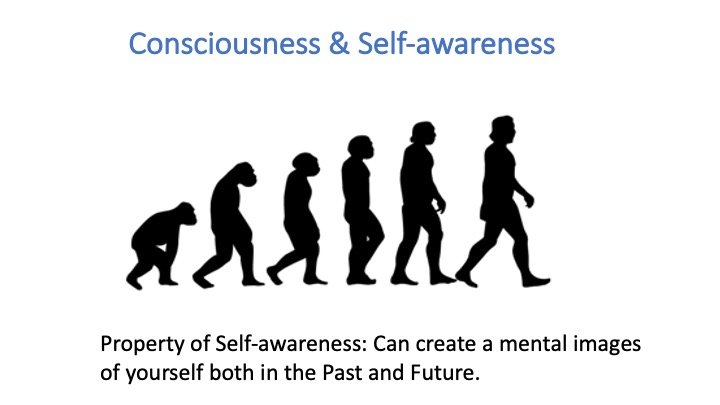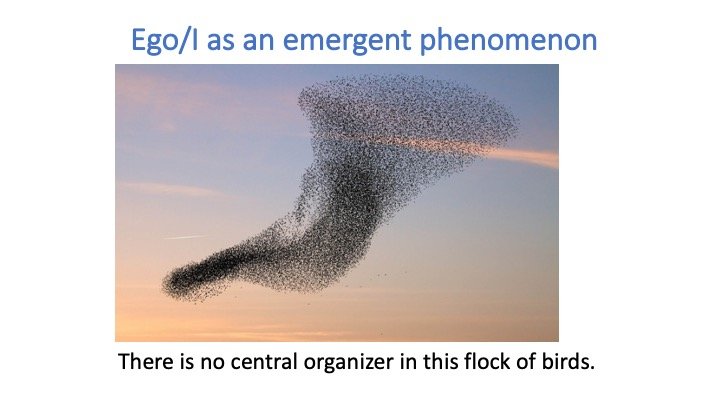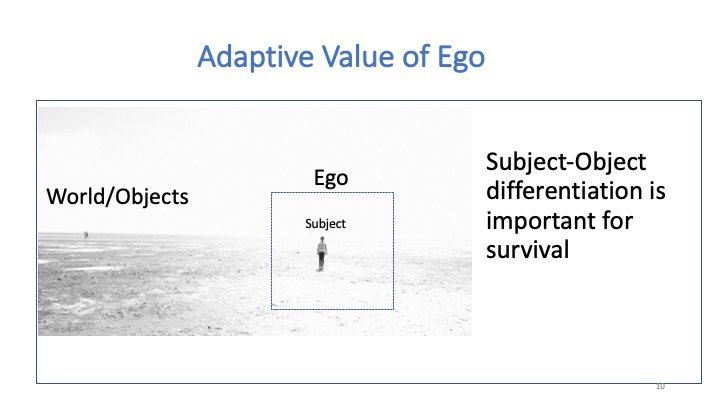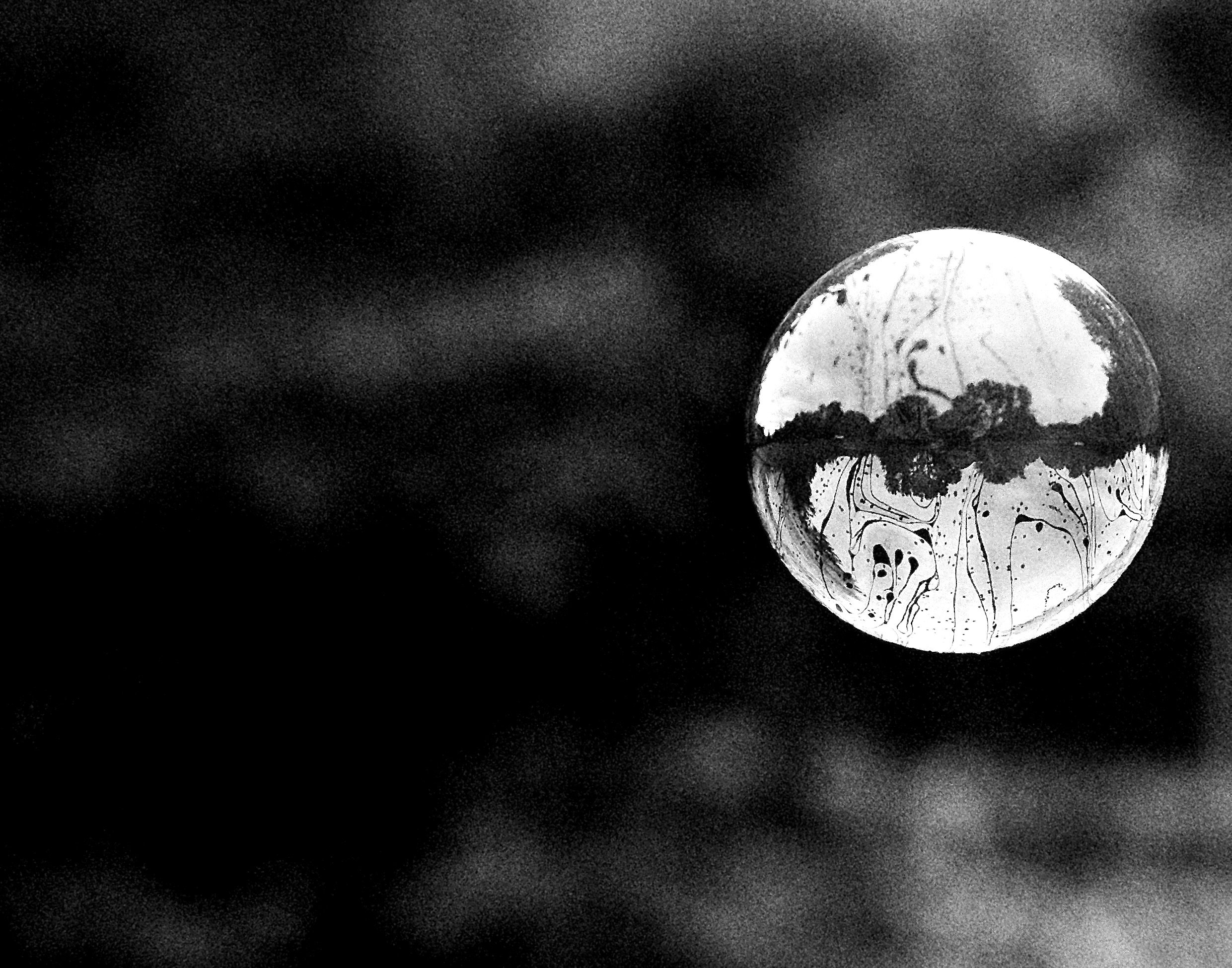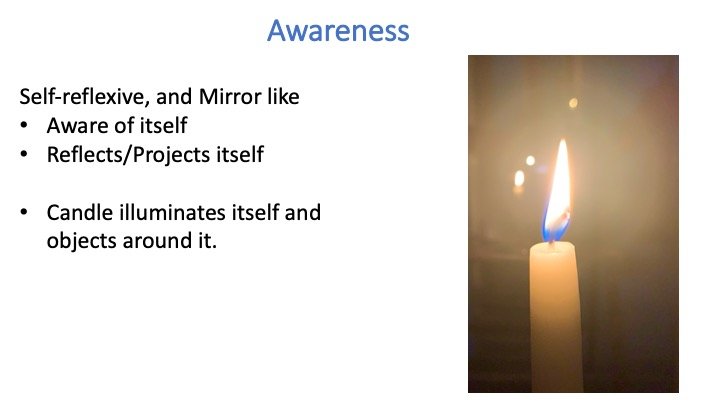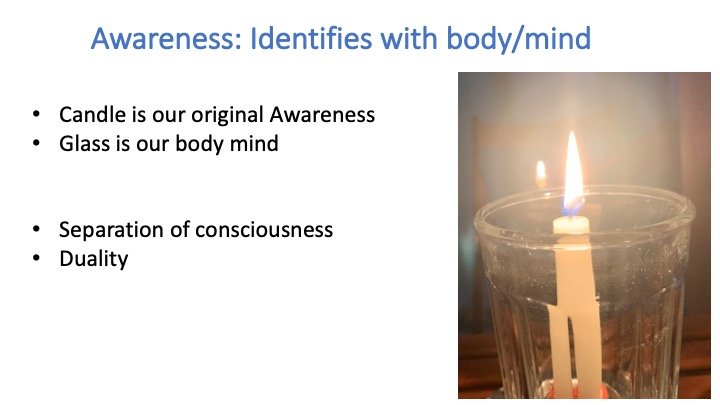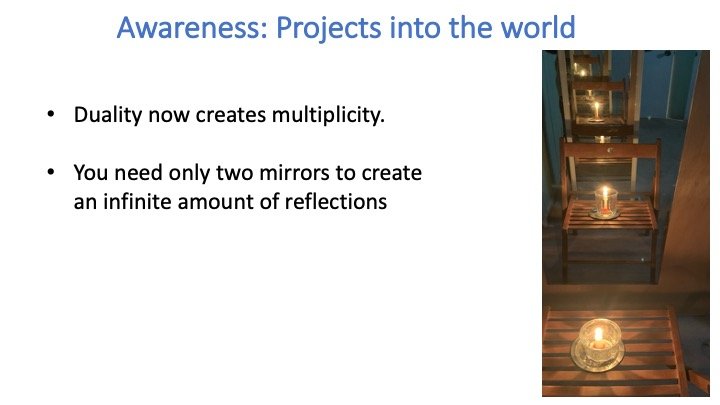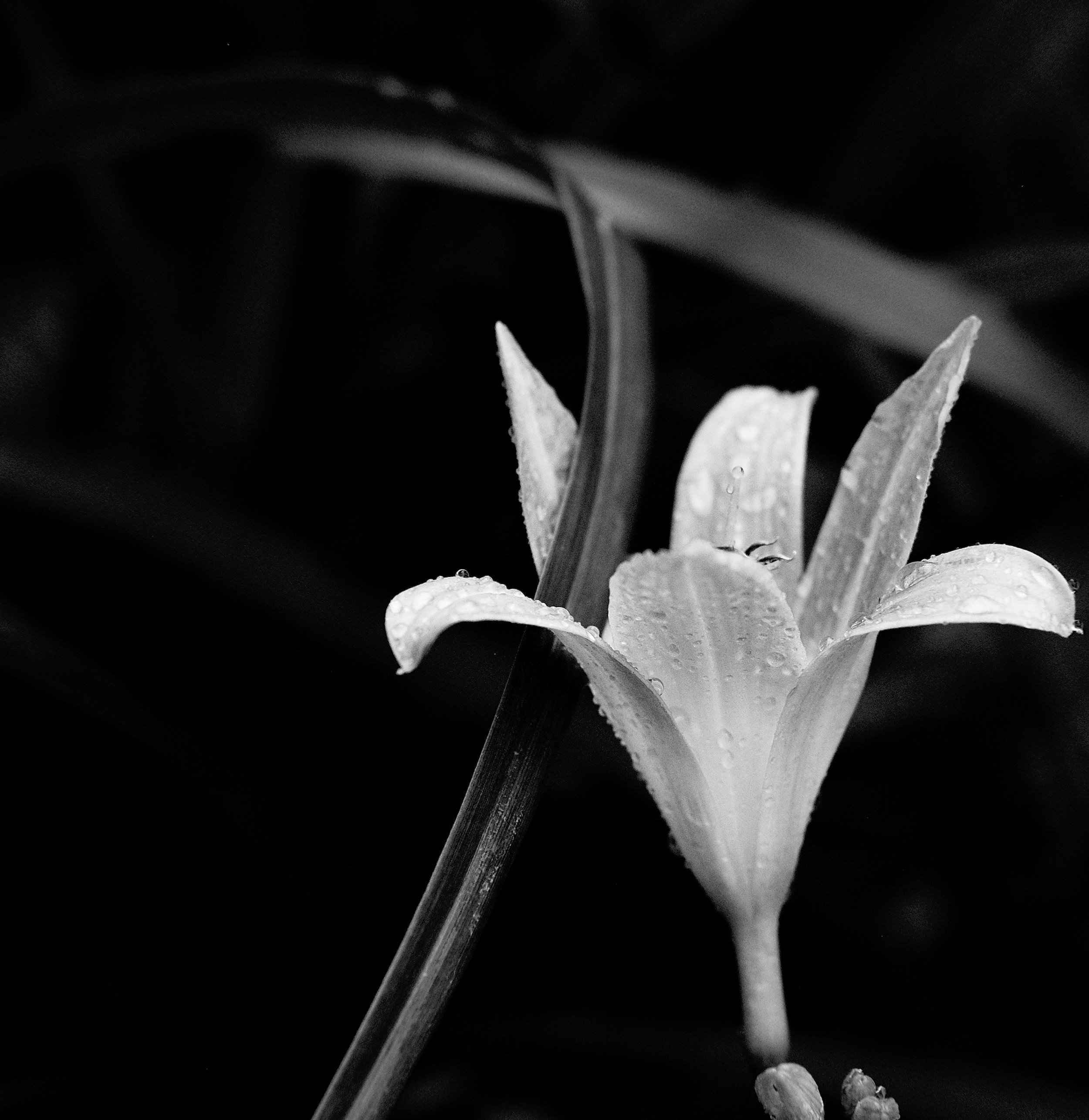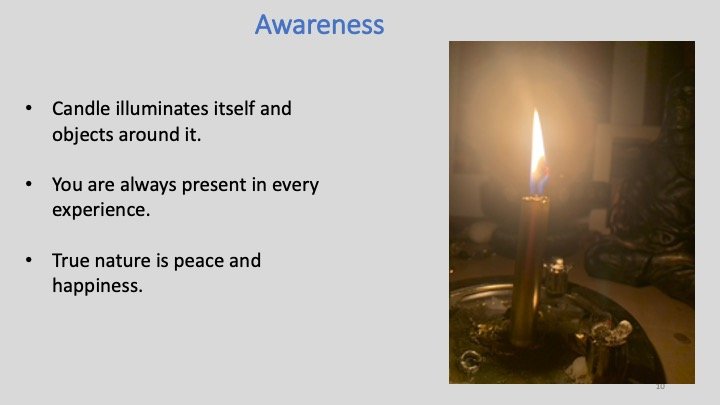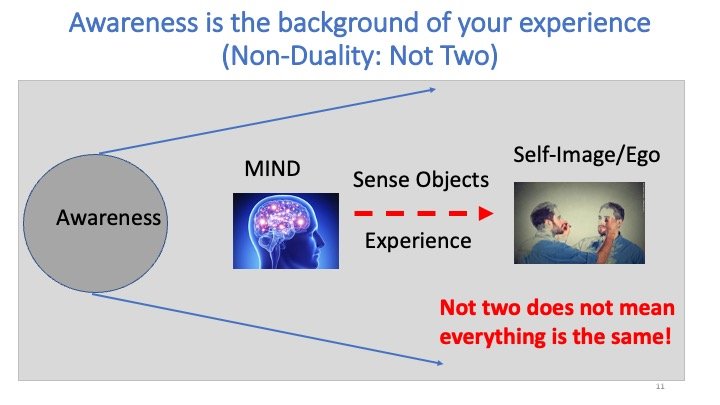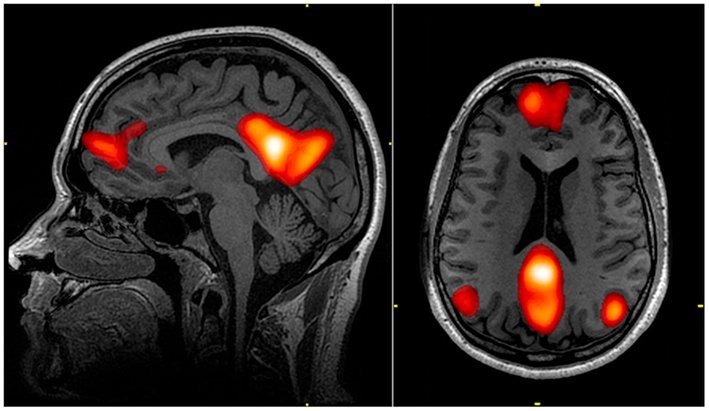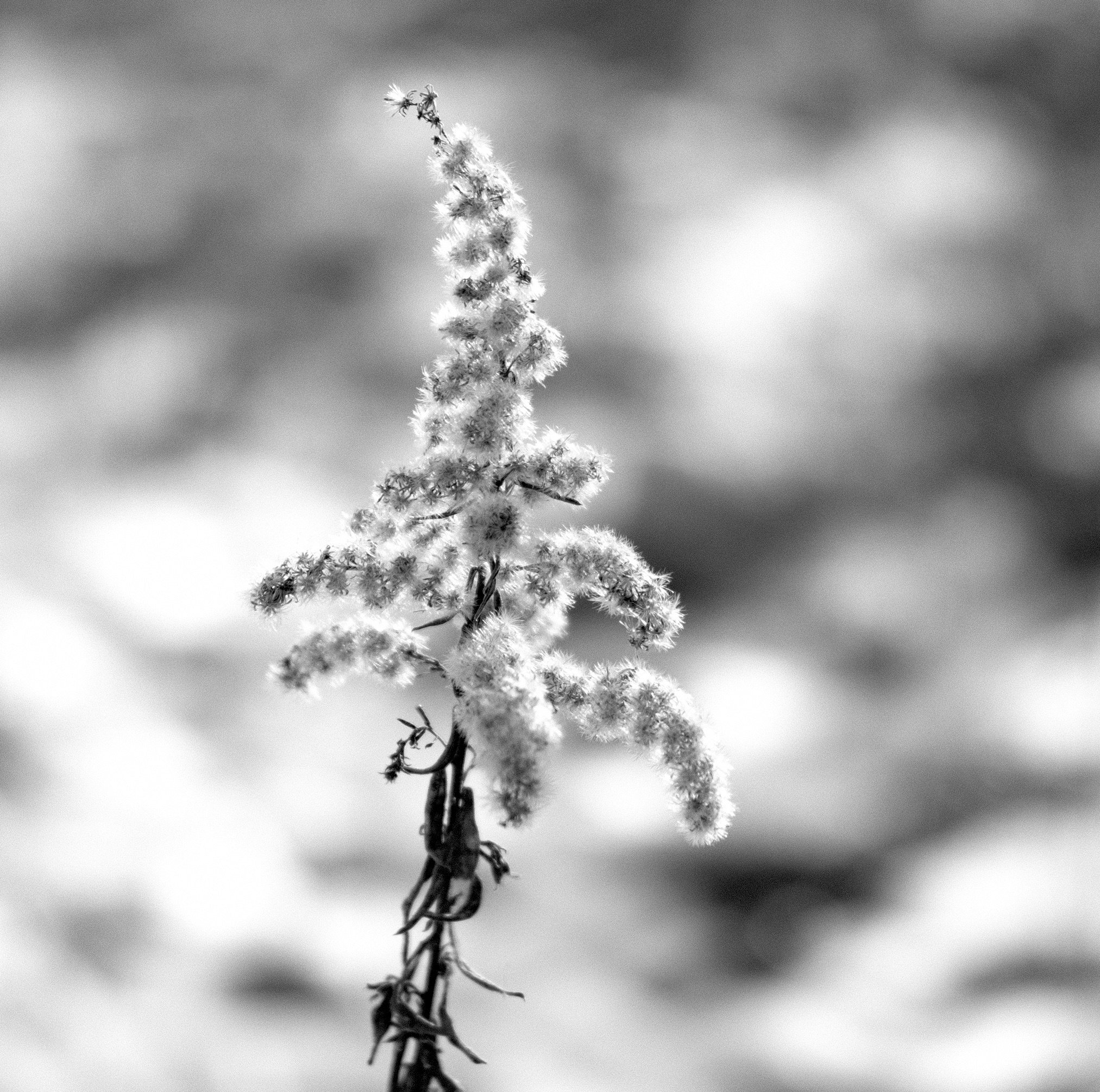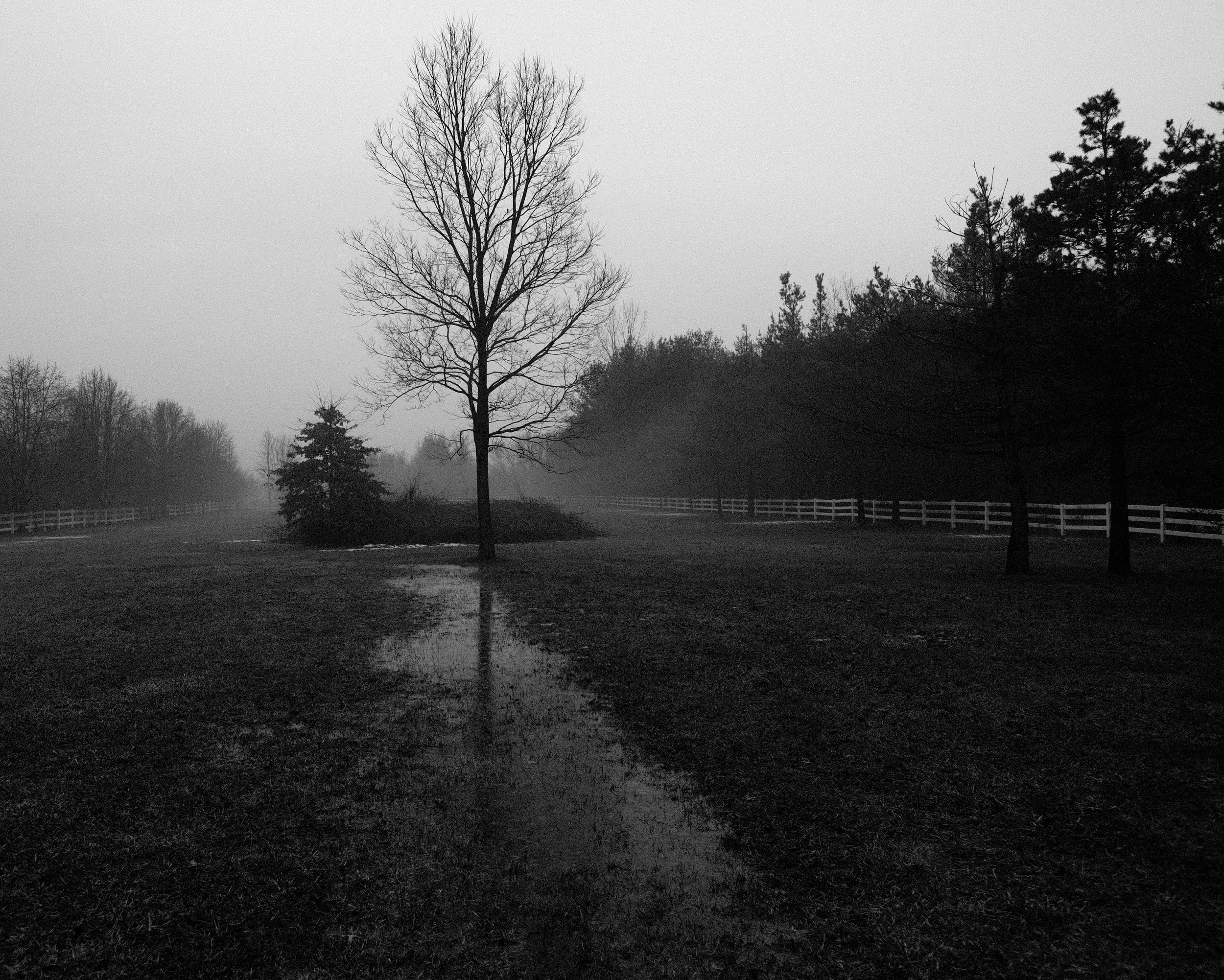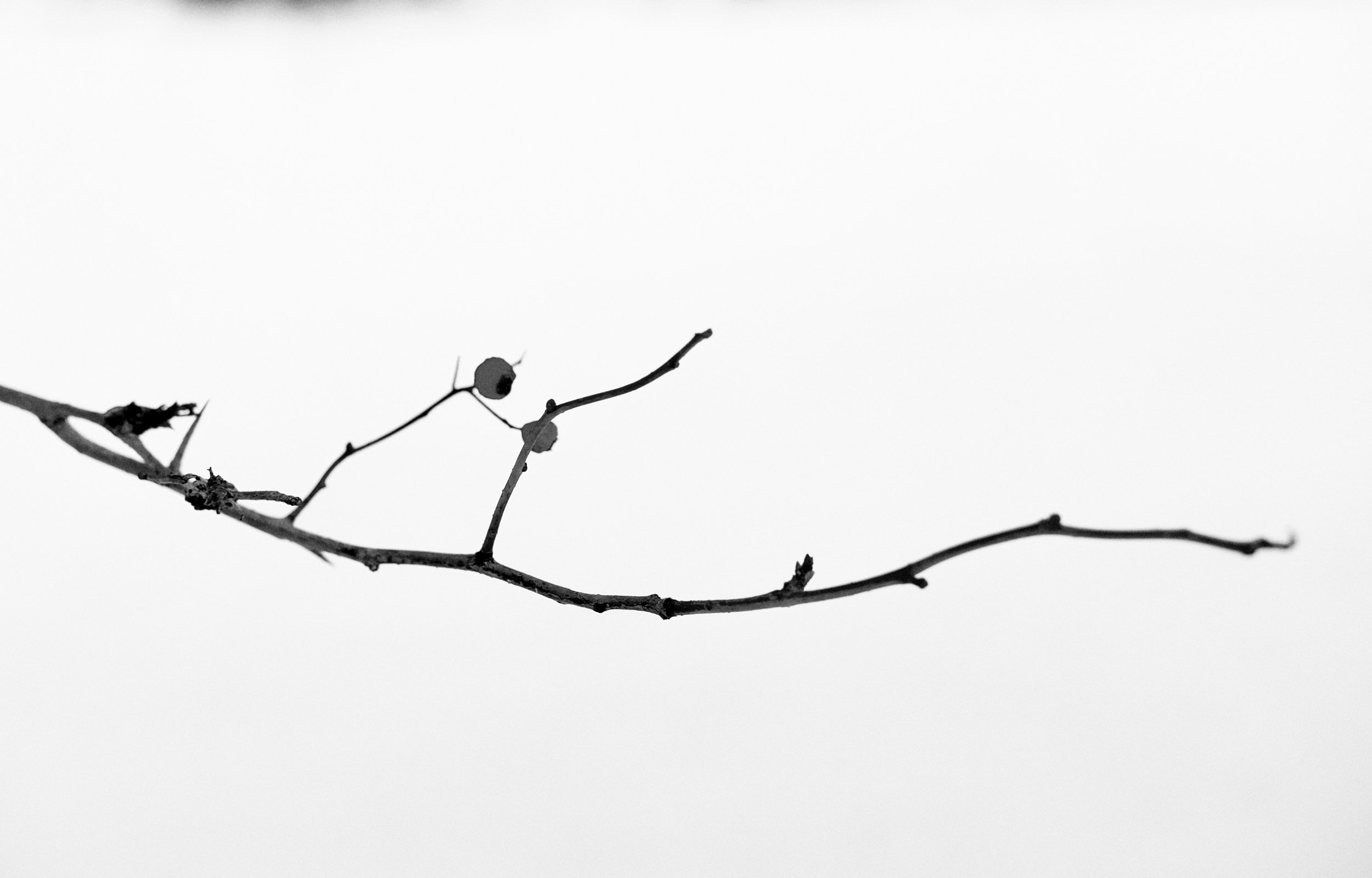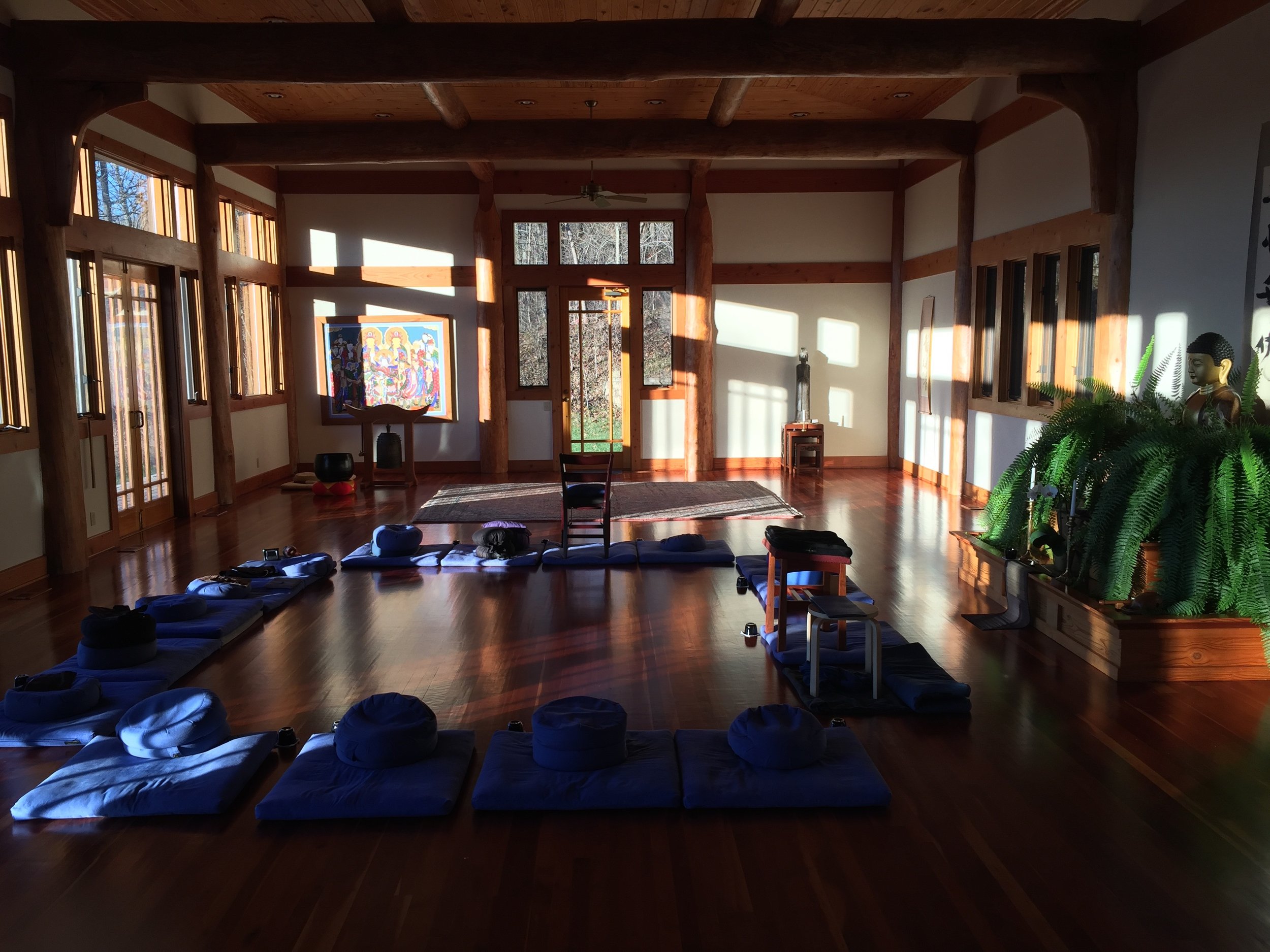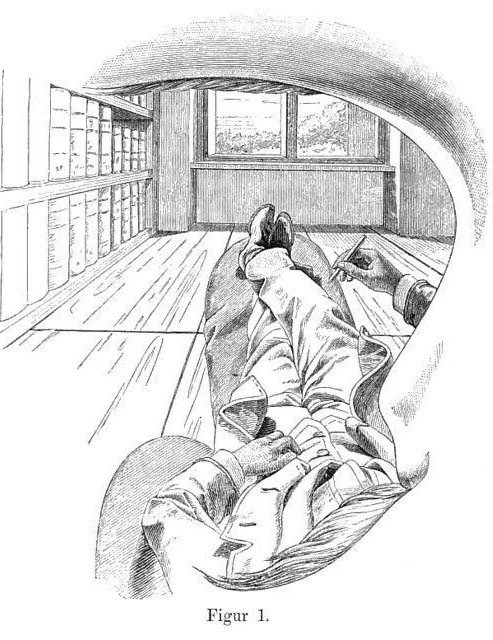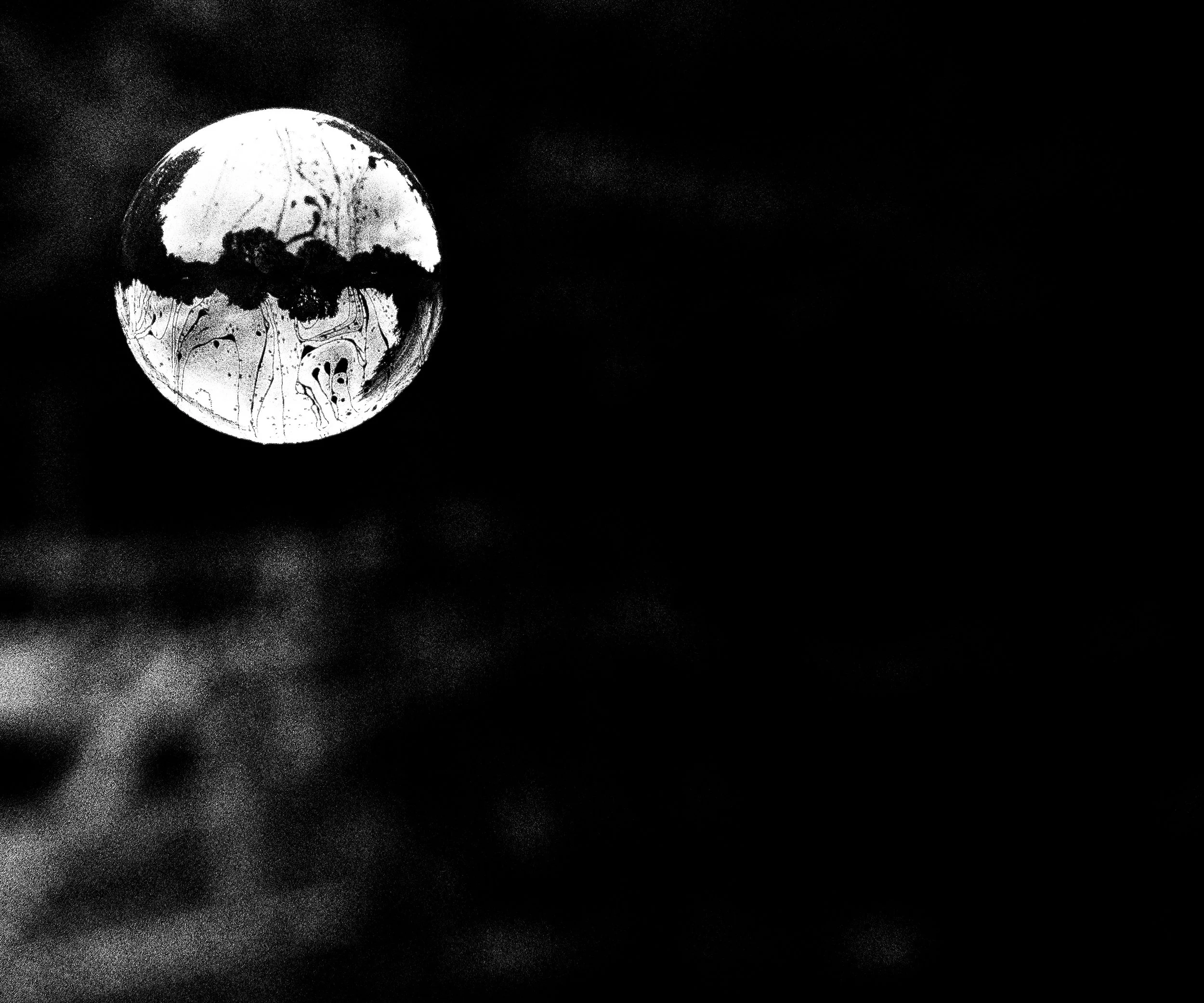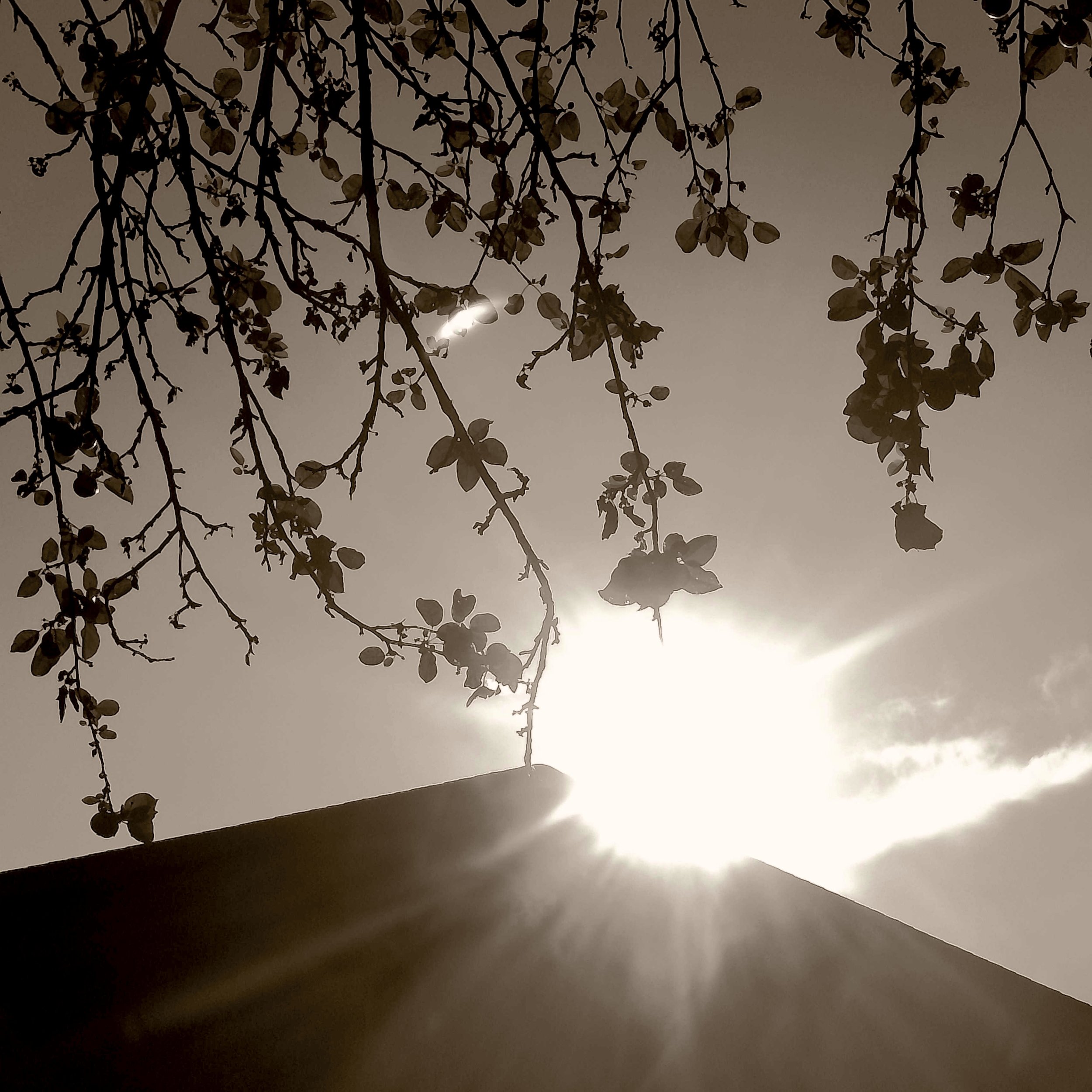Samskaras, Vasanas and Groundhog Day
Samskara in Eastern philosophy refers to psychological imprints left in the subconscious by our daily experiences—whether conscious or unconscious, internal or external, desirable or undesirable. These imprints are not merely passive vestiges of our actions and intentions, but dynamic forces in our psyche
Groundhog Day
Groundhog Day is one of my favorite movies of all time and I recently had a chance to visit the place that the movie is based on, a quaint little town in the middle of nowhere called Punxsutawney in Pennsylvania. For those who haven’t seen the movie, Groundhog Day tells the story of a cynical television weatherman covering the annual Groundhog Day event in Punxsutawney, Pennsylvania, who becomes trapped in a time loop, forcing him to relive February 2 repeatedly.
I got interested in the movie and its spiritual implications when I was attending a Zen retreat where the visiting teacher, a movie critic, gave a lovely talk on relationship between the movie and spiritual practice.
The Three Layers of Consciousness
To understand samaras and Vasanas, it is good to have a general understanding of how consciousness is described in eastern traditions. In Eastern traditions, our everyday waking consciousness is just one aspect of our entire experience of the world. Typically consciousness in these traditions is divided in three layers, the gross layer, the subtle layer and the deepest layer, called causal layer or alaya consciousness. The karmic imprints for our actions reside in the deepest layer of our consciousness.
In these traditions, most of our everyday actions are determined by these karmic imprints. If you have ever wondered why you end up with the same circumstances in your life despite your conscious effort to change, it is because of our samskaras. Our conscious actions are determined by conditions that reside in our deeper layers of consciousness and are not accessible to our waking consciousness except in deep meditation.
What are Samskaras and Vasanas?
Samskara in these traditions refers to psychological imprints left in the subconscious by our daily experiences—whether conscious or unconscious, internal or external, desirable or undesirable. These imprints are not merely passive vestiges of our actions and intentions, but dynamic forces in our psyche. They constantly push the person into action. These impressions wait to return to the conscious level of the mind, influencing our future in the form of expectations, sense of self-worth, habits, innate dispositions, and emotions—propelling our lives and generating future karma.
Vasana means “to remain,” “to dwell,” “to persist (in memory). Think of Vasanas as “Chains of Samskaras”. In the Yoga Sutras, Patanjali defines vasana as a dynamic chain or concatenation of samskaras. The term vasana is associated with the notion of subtle desire. Because of all the desires we have in daily life, subliminal traces or subtle fingerprints remain in our minds. Within the Causal Layer, the vasanas lie dormant until their “input” is required by the intellect in order to make a decision about how to interpret and respond to a given stimulus. So, for instance, the next time an opportunity for one to share intimacy arises, the vasana formed by our previous pleasurable experience will “tell” your mind that intimacy is enjoyable and you should go ahead and engage in the activity.
Each time we engage in a particular activity or indulge a given vasana, we strengthen it. In this way, over time vasanas gain a sort of life of their own. That is, rather than simply waiting around to be consulted by the intellect when it has to make a decision related to an object with which the vasana is associated, the vasana begins to demand satisfaction, as it were. This is the cause of our desires, attachments, habits, and, in extreme cases, addictions. When they are indulged regularly, vasana can grow strong enough to assume control of our mind.
Vasanas are what make us live in a state of constant agitation—always planning the future and thinking about the past. This prevents us from living in the state of clarity that arises in the awareness of the eternal present moment. In many Eastern traditions this is depicted by a wheel, the constant desire to seek satisfaction from the world around us. Each step feeds on itself and we are constantly cycling between these mental states.
The Six Realms and Flow of Consciousness
Spiritual Practice and the movie Groundhog Day
Below is the talk, and the review of the movie given by Dairyu Michael Wenger, Roshi. It is a beautiful talk that highlights the relationship between spiritual practice and overcoming our Vasanas.
The film Groundhog Day demonstrates the wonder of living each moment as a totally new event. It follows a day in the life of weatherman Phil Connors, a sarcastic curmudgeon. He wakes upon the same day, Groundhog Day, again, and again, and again. His namesake, Phil the groundhog (himself a weatherman), sees his shadow, is frightened and goes back into his burrow, thus predicating six more weeks of Winter. Phil Connors is frustrated by living the same day over and over again. He wants to get somewhere else, find new circumstances, he tries to escape each day with the scenarios of his life. He pursues sex, but after a while it is a dead end. Crime is exciting but becomes tiresome. Drinking, therapy, suicide, finding a love relationship, all are explored. The habits and shadows of his life are found wanting.
Each action has consequences. This is the law of karma: he has a choice, but each choice leads to a new reality. Perhaps the turning point of the movie is when he tries to save a homeless man day after day after day, and, no matter what he does, the man dies. He really wants something and is powerless to insure its happening. We have freedom, but within limits. This is “samsara” in Buddhism, the cycle of becoming driven by our karmic intentional activity. We have desires and wants but we may never reach them. Eventually, through many days [lifetimes] he chooses a life of service, works through his demons, and breaks the cycle of Groundhog Day.
Each moment becomes a new opportunity, so the same situation is brand new and his unique response leads to a unique result.
If we recognize what is driving us, and clarify our true intention, the unexamined shadows are no longer about some solely external reality or objective weather, but about us. Each moment is a new beginning. Our projections and stance in the world can cast a long shadow on our lives, and the Spring of each moment is postponed for a long Winter. If you examine and test your perceptions, each moment brings forth a new world. If we lead an unexamined life, we feel each day is different, but it is really a rerun of our habits. If we examine a disciplined life closely, each instant can blossom into a unique flower.
This film parallels Buddhist practice. In a training temple, the wake-up bell rings the same time every day. You go to the same place, wear the same clothes, and follow the same routine, and yet each moment is unique. Not distracted by your desire for changed conditions, you can live each moment not knowing what it will bring, seeing the familiar landscape with new eyes.
Phil Connors in the end “wins the girl.” He gives up trying to possess her, so that true intimacy, true participation, can occur. Affecting and being affected by each other and each thing is the true interpenetration of self and other.
The cycle of samara is broken, his shadows are seen through, and each moment blossoms. Phil Connors comes out of his burrow to the market place with gift bestowing hands. He sees the shadow of his reflections and bows to it, as it must to him
Spotify Link to this episode
What did Sri Ramana Maharishi mean by the I-Thought?
I-thought is another name for the Ego. The ego functions as the knot (granthi) between the Self, which is Pure Consciousness (chit) & the physical body which is insentient (jaḍa).
Sri Ramana Maharishi Introduction
For those who don’t know, Ramana Maharishi (30 December 1879 – 14 April 1950) was one of India’s greatest sages and taught in the tradition of Advaita Vedanta. He awakened to his true nature at the age of 16 after having a death experience. He spent the rest of his life near the holy mountain Arunachala, in Tiruvannamalai. His most two most famous books are Ulladu Narpadu, (40 verses on the Nature of What-Is) and Nan-Yar, (Who Am I?).
Misunderstandings Regarding the I-Thought and Self-Inquiry
The most common misunderstanding is that the I-Thought means, the thought “I-AM” and that self-inquiry is either fixing your attention on the I-AM or even worse, recognizing that the I-AM is a just a thought, and this recognition is equivalent to enlightenment. Many teachers have deluded themselves into thinking that they are enlightened based on these misunderstandings, and caused a lot of confusion to sincere seekers of truth. Another common myth is that the I-thought corresponds to the default-mode network (DMN), and suppressing the DMN or a thought free state is equivalent to enlightenment. While I agree that quietening the mind to some degree is useful in any spiritual path, conflating a quiet mind with enlightenment is a gross misunderstanding of Sri Ramana Maharishi’s teaching.
Most people claiming inspiration or lineage to Ramana Maharishi haven’t actually studied Ramana Maharishi’s teachings in any great depth, picking and choosing statements that suits their viewpoints. Also, Ramana Maharishi never appointed any successors so the idea that there is an unbroken lineage going back to Ramana Maharishi is ludicrous.
So what did Sri Ramana Maharishi Mean by the I-Thought or Aham-Vritti?
So what did Ramana Maharishi mean by the I-thought? According to Ramana Maharishi, the I-thought is nothing other than Ego. According to Sri Ramana Maharishi, the Ego, is an emergent phenomenon that arises when Infinite Awareness conflates itself with this body, thereby causing an inherent sense of limitation in ourselves that manifests as subject-object duality. Because of this conflation our experience of this world is temporal and is restricted by space and time. This conflation, he calls Chidabasa (semblance of awareness) or Chit-Jada-Granthi (the knot connecting the insentient body (jada) & chit (awareness). In other words, the I-thought or Ego is a knot that is formed when awareness that is infinite and unbounded, contracts into the spatio-temporality that we experience as the body-mind. Also, when Ramana Maharishi means body, he does not only mean the physical body but also the subtle body (Mind-Intellect-Ego) and the causal body (unconscious).
Don’t believe me, here are a few references from his own writings that explain this idea in more detail.
Verse 18 of Upadēśa Undiyār:
Mind [is] only thoughts. Among all [the countless thoughts that we form in our mind], the thought named ‘I’ alone is the mūla [root, base, foundation, origin, source or cause]. [Therefore] what is called ‘mind’ is [in essence just this root thought] ‘I’.
Verse 2 of Āṉma-Viddai :
The thought ‘this body composed of flesh is I’ indeed [is] the one thread on which [all our other] various thoughts are strung …
Alert, Sri Ramana is clearly stating that our identification with the physical body is what causing the primal misidentification. The root I-thought is the first thought from which all other thoughts arise, and he is clearly stating that it is the identification with our body that is causing the problem.
Maharshi’s Gospel (13th edition, 2002, page 89):
the ego [our mind or primal thought ‘I’] has one and only one [relevant] characteristic. The ego functions as the knot [granthi] between the Self[,] which is Pure Consciousness [chit][,] and the physical body[,] which is ... insentient [jaḍa]. The ego is therefore called the chit-jada granthi [the knot between consciousness and the non-conscious]. In your investigation into the source of aham-vritti [the thought ‘I’], you take the essential chit [consciousness] aspect of the ego; and for this reason the enquiry must lead to the realization of the pure consciousness of the Self.
SPOTIFY Link to the Podcast
The Phenomenology of Awakening: Training Attention
One key practice for awakening is training the direction of your attention so that it can focus on one thing at a time. Our minds are usually distracted and we typically have trouble focusing on one thought stream at a time. The following exercises will allow one to focus their mind on one object at a time.
Recap: Nature of Awareness
M
Awakening: Reversing the direction of attention
The great Zen Master Dogen wrote in the Fukanzazengi:
“You should therefore cease from practice based on intellectual understanding, pursuing words and following after speech, and learn the backward step that turns your light inwardly to illuminate your self. Body and mind of themselves will drop away, and your original face will be manifest.”
Make it stand out
Prerequisites for Awakening: Training Attention
One key practice for awakening is training the direction of your attention so that it can focus on one thing at a time. Our minds are usually distracted and we typically have trouble focusing on one thought stream at a time. The following exercises will allow one to focus their mind on one object at a time. In these exercises we focus our attention on one sense object at a time. For simplicity, in this exercise we focus on sound but this can be done with any sense object.
The point of all of these exercises is to understand that to investigate the nature of reality we need to have a mind that is not distracted by thoughts. A stable mind is a prerequisite to understand how the mind constructs our reality.
Default Mode Network (Monkey Mind)
As we begin our meditation practice, we quickly realize that when we sit to meditate our minds seem to be out of control. Our minds are very jumpy with a constant thought stream and we are constantly distracted by an uninterrupted stream of seemingly endless thoughts. Neuroscientists call this the Default Mode Network, or DMN for short. In Eastern traditions, this is called the monkey mind. The first step is to give the monkey mind something to do.
Please refer to my previous blog post (https://www.awakeningofimpermanence.com/blog/defaultmodenetwork) that describes the default mode network and strategies to tame the default mode network (https://www.awakeningofimpermanence.com/blog/tamingdmn).
Exercises for Training the Mind
Checklist before starting meditation
Intent to practice: Intention to meditate
Sharing the benefits: Resolve to share the benefits of your practice with your fellow beings. Typically we want benefits for ourselves, and sharing the benefits with our fellow beings allows us to step out from our self-centered world view.
Posture: A relaxed posture is beneficial to good practice.
Breath: Deep long breaths have a beneficial effect on the default mode network.
Field of Care: Think of a family member/pet or deity to create a protective field of care.
Relax: Relax body and mind. Relax some more.
a) Step 1- Relaxing the mind
The first step in this process is to relax the mind. Relaxation allows one to notice the working of the mind instead of getting caught up in the mind stream.
b) Step 2- Training the Arrow of Attention
In these exercises you focus your attention on listening to one sound stream at a time in the beginning followed by more complicated sound streams. The idea behind these exercises is to keep your attention on the object, in this case sound. Through this practice as we get more familiar with focusing our mind on one object, the mind automatically gets concentrated. This concentration lends stability to the mind when it investigates the nature of our consciousness.
Beginning Exercises:
Non-Dual Meditation Exercises
Next steps:
As you get facile with holding your attention on an object, you then increase the amount of time focusing on a particular sound or sense object.
Typically you hold attention on objects for 30 minutes to 1 hour.
As you progress in this path it will be easier to have insight to the workings of the mind.
The Phenomenology of Awakening: Theory
Phenomenology is the study of the structure of experience and consciousness from the first person perspective. The primary objective of phenomenology is the direct investigation and description of phenomena as directly experienced, without theories about their causal explanations.
Tree in Fog
Why the term Awakening and not Enlightenment?
It is important to realize that the term ‘enlightened’ was first used by Max Müller ( 1823 – 1900) to describe the Buddha in 1857. For various reasons it has become the standard translation of Bodhi (literally ‘awakening’). Cohen (2006) points out that ‘enlightenment’ is an incorrect translation because Bodhi is more process-oriented, whereas ‘enlightenment’ is event-oriented. Enlightenment also suggests an illumination from the outside, a metaphor that is common in the Christian tradition where a person can be enlightened by God or the holy spirit. Awakening, by contrast is a personal transformation or realization of one’s true nature from within. It requires personal effort to free yourself.
What is Phenomenology?
Phenomenology (from Greek φαινόμενον, phainómenon "that which appears" and λόγος, lógos "study") is the philosophical study of the structures of experience and consciousness. Phenomenology is interested in study of the direct investigation and description of phenomena as consciously experienced, without theories about their causal explanation and as free as possible from unexamined preconceptions and presuppositions. As philosophical movement it originated in the early 20th century through the work of Edmund Husserl in Germany.
Hard Problem of Consciousness
One related issue to phenomenology, is what David Chalmers calls the hard problem of consciousness, ie how do cognitive and behavioral functions give rise to a felt sense of someone who is having an experience. For example, why should neural processing in the brain lead to the felt sensations of, say, feelings of hunger?
even when we have explained the performance of all the cognitive and behavioral functions in the vicinity of experience—perceptual discrimination, categorization, internal access, verbal report—there may still remain a further unanswered question: Why is the performance of these functions accompanied by experience? (David Chalmers, Facing up to the problem of consciousness).
Can there be an objective measure of Awakening?
If the hard problem of consciousness is true, and there is no reason to believe why it cannot be true, it means that awakening can never be something that can be objectively measured. It is important to realize that most of the descriptions that we read in religious texts are actually first person accounts of people’s experiences. Things like chakras, kundalini, subtle body etc are first person accounts of peoples experiences as they enter various meditative states. Even if we do fMRI studies of people’s brain all we can do is measure these neural processes, and compare them to the person reported experience of that event. There is no objective way to measure someone’s felt experience of an event because it is a subjective experience.
My hypothesis is that the only way to compare the validity of one personal experience of awakening is to look at records of other people’s experiences (scriptures), use rational analysis (intellect) and see if you experience is in the ball park of the reported experiences. This is an empirical method which is rigorous and allows for the validity of a personal experience.
What does Non-Duality mean?
The word non-dual has been commonly used to describe the traditions extant in some of schools of Hinduism and Buddhism but non-dual traditions of Christianity and Islam exist as well . The fundamental premise of all non-dual traditions is that the apparent separation that we feel between ourselves and the world around us is because of a lack of understanding of our true nature. This apparent separation is the cause of all our suffering because we are always trying to bridge this separation by seeking objects of the world to complete us. Here objects are not only physical possessions but also mental constructs like pleasure derived from sense objects.
Our true nature is described as Sat-Chit-Ananda, commonly translated as existence-consciousness-bliss in the Hindu Vedanta traditions. In non-dual schools of Buddhism it is called Tathagata ( Buddha-nature). All tathagatagarbha sutras agree that the tathagatagarbha is an inherent, transcendent essence that resides in a concealed state in every being.
Axiomatic Nature of Awareness: Original Consciousness (Sat-Chit-Ananda)
The commonly accepted definition of axiom means self-evident truth. If we observe our consciousness carefully, it becomes obvious that we do not need any outside validation to know that we exist. The only thing that we can know without any outside input is that we exist. The fact that we exist is a self-evident truth. This Awareness knows itself and objects of the world. A commonly used metaphor describes Awareness as similar to a candle. A candle illuminates itself and objects around it. You don’t need a flashlight to illuminate the candle. It is Self-Luminous.
One of the key premises of all non-dual traditions is the description of an aspect of our consciousness (Awareness) that is outside of conventional descriptions of space and time. If we observe our Awareness, we can see that Awareness has no beginning and no end. It is outside conventional descriptions of space-time that we typically use when we describe our everyday consciousness. This Awareness is typically described as sat-chit-ananda. Sat is translated as Existence, Chit is consciousness and Ananda is bliss. So our true nature is Satchitananda is existence-consciousness-bliss. In certain schools of Hinduism, Awareness is also described as AJati (A-Not; Jati-Birth), which literally means Not-Born or outside of conventional descriptions of space and time.
If experience is non-dual why do we experience duality?
This separation is an artifact of being self-aware. We as humans can create images of ourselves in the past and future. This identification of the awareness with our own self-image creates a further disconnect between the world and us.
If we notice our children growing up, at the beginning they don’t have a fully formed sense of self, they are not able to distinguish between themselves and the world around them. As they start processing sensory stimuli, information from the world around then, they start getting a felt sense of I.
The Dualistic Nature of our Current Experience
As we look into our daily experiences, we realize that there are two aspects to our experience that stand out. We (Subject) and the world (Objects), and a vast almost, unbridgeable separation between the two. Except for a few rare occasions, where this sense of separation drops away, and we feel fleeting peace, we are constantly striving to bridge this separation. A sense of dissatisfaction (Dhukka) that arises from this separation is the primary cause of our suffering. Our consciousness is trying to bridge this separation by looking for happiness in the world of objects but it is impossible to feel complete from experiencing objects.
3 bodies in Samkhya: Models of Consciousness
Another thing that is worth discussing is that what the eastern traditions call body-mind is just not the physical body and the mind. In Samkya philosophy it is described as further the gross body, subtle body and the causal body. The subtle body is made up of the Mind-Intellect-Ego and the causal body is our Unconscious. In Vedanta it is described as the 5 Koshas, which is typically translated as sheaths.
It is important to realize that these are descriptions about the nature of consciousness not descriptions of reality or metaphysics. There is no objective way to measure the existence of a subtle or causal body.
Ego as an emergent phenomenon
The Ego is created when our Awareness/Original Consciousness identifies itself with the mind-body complex. Remember that the mind-body complex is not just our physical body but also encompasses the subtle and causal body as described above. This identification of Awareness with the mind-body complex creates the Ego. This Ego is an emergent phenomenon, meaning it is not reducible to a discreet entity. The sum is greater than its parts.
To be clear, even though the Ego is an emergent phenomenon it does not mean that the Ego is unreal. A lot of people commonly misunderstand the descriptions of Ego in eastern tradition as denying the existence of an Ego but what is being described is that ego cannot be reduced to the sum of it parts. Within the realm of the body-mind complex the Ego is real. One only needs to see the suffering humans have inflicted on each other to understand how pernicious the ego is in our consciousness.
Original Sin-Maya-Separation
As this process of the creation of an Ego continues, the newly created entity starts believing it controls the body mind complex. This separation becomes solidified into an entity called “I”. This “I” starts believing that it has an independent existence outside of the body-mind complex, and believes that it controls the body-mind.
At this point the separation of Ego from Awareness is complete. Ego now acts an independent entity that has an existence separate from the Original consciousness.
Samsara and 6 realms: Bridging Separation
As the Ego solidifies, it starts feeling this sense of separation. This pervasive unease (Dhukka) that all humans feel is because of the inherent transience of the Ego. This Ego is fundamentally unstable and is constantly looking for stability outside of itself through the sense objects/mental constructs.
1- God Realm (Pleasure): We seek gratification through sense objects and mental constructs
2- Demon Realm (Jealously): Being possessive of the objects we create pleasure from
3- Animal Realm (Ignorance): We don’t understand these objects are temporal
4-Hungry Ghosts (Craving): Not being satisfied. Constantly chasing objects despite having enough.
5- Hell Realm (Hatred): Violence
6- Human Realm (Freedom): Buddha Nature is always within us.
Buddha was a phenomenologist: Everyone Begins Here (Redux)
The Buddha was a phenomenologist par excellence. Buddha, unlike the many traditions extant during his time never indulged in metaphysical abstractions about the nature of reality, buddha-nature’s existence or non-existence. He focused on the nature of suffering, and how to end suffering. That said, I have included a basic description because whether we like it or not, our mind needs to be clear about the nature of practice and the reasons for practice. Otherwise, we will be involved in meaningless rituals or meditating without understanding the problem we are trying to solve.
SPOTIFY Link to the Episode:
References:
1. Cohen, Richard. 2006. Beyond Enlightenment: Buddhism, Religion, Modernity. London: Taylor & Francis.
2. Ramm,Brentyn 2021. The Technology of Awakening: Experiments in Zen Phenomenology. Religions 12:192
3. James Swartz: Book of Charts
.
Sunset
Awakening is Not Permanent Bliss
Because of the evolutionary pressures acting on the mind, our minds are exquisitely adapted to not be in a state of stasis. From an evolutionary perspective, stasis means death of the species. This means that our minds are adapted to react and change constantly to various stimuli from the outside world. This means any experience gets boring after a while.
Tree in Fog
The eye does not see
As we start looking deeply into the nature of our experience, we commonly make the mistaken assumption that there is world of objects out there, and we, as the subject experience the world as separate from us. That said, even a simple intellectual analysis of our sense experiences will show that the world is in fact experienced in the mind. For example, even though we might believe that the eye sees, all it does is receive light signals and it is our brain that interprets those light signals and creates a visual representation in the mind. It is the same with sound, the ear does not actually hear anything, it just receives sound waves and our brain interprets these sound signals to give us the experience of sound.
We experience the world in our mind
Our experience of the world is through our sense objects. These sense objects receive signals, and then our brain interprets these signals to create a world out there that we experience. Just to be clear, experiencing the world in our mind does not mean that the world is unreal or it is an illusion. What it means is that our experience of the world happens in our mind. Without the mind, the world does not exist. For example, in deep sleep, the sense objects are in a state of statis so the world that we experience in the waking state does not exist.
I have to reiterate that this description of reality is from the perspective of the subject, meaning the person who is sleeping. For the person sleeping, the world does not exist for him. It does not make sense to ask the question from the state of an external observer because we experience the world from our subjective perspective. Obviously, we can agree on a shared reality, meaning two people can see a table and agree that they see an object that has four legs and is made of wood or metal.
Our minds are shaped by evolution
Just like most animals, our human mind is shaped by evolutionary forces. Like all living beings in our planet, our minds react to stimuli in similar ways.
1- We chase pleasurable stimuli
2- Recoil from painful stimuli
3- Indifferent to neutral stimuli.
We as humans are hardwired to chase after pleasure and avoid pain. From an evolutionary perspective this makes sense because it ensures the survival of the species. Chasing pleasurable stimuli is a good thing for us because it helps propagate the species, and running away from painful stimuli ensures the survival of the species.
Our brains are hardwired to get bored
Due to evolutionary pressures acting on the mind, our minds are exquisitely tuned to always be in a state of constant seeking From the viewpoint of evolution, stasis means death of the species because if one is happy irrespective of circumstances then there is no need to search. Not seeking means death of the species. These evolutionary pressures allow the mind to react and change constantly to various stimuli from the outside world and because of this any experience gets boring after a while. The best vacation, the most pleasurable experience, the best food, your favorite car etc., all of them get boring after a while because the nature of the mind is to constantly seek new objects. This is samsara, the state of constant seeking, looking for the next big thing or experience.
What this means is that the brain is hardwired to lose interest after a while. Even blissful mental states generated through the practice of meditation will end. That is how our brains are wired. Chasing blissful states will not make any meditator happy. On the contrary, trying to recreate a blissful meditation experience will inevitably lead to frustration because of the inherent nature of our mind.
Awakening will not lead to a state of permanent bliss
One common misconception among many spiritual practitioners is the expectation that enlightenment or awakening is a state of uninterrupted bliss. The assumption is that if one gets enlightened then all the problems of the world would go away, and all the person will be in a constant state of everlasting ecstasy. In fact, the literal translation of Nirvana, (Nibbana in Pali) is extinguish or blow out.
If we assume that awakening happens in the mind, it follows that any pleasure that is experienced by the mind will get boring after a while. Any trance state, or drug induced ecstatic state will end, and will also get more and more difficult to recreate because the mind is hardwired to move to the next hypotheticallyl great pleasurable experience. This is the exact same reason why taking drugs to stimulate awakening will not work because awakening is not a mental state. Any state is temporary. Awakening does not come and go depending on your mood or mental state.
Indicators for Genuine Awakening
I believe that there are a few good indicators to determine the difference between a genuine awakening versus another mental state or construct. Of course, as with most things there are no guarantees, and the practitioner should always be aware of the tendency of the ego to co-opt a genuine spiritual awakening as its own. As the Katha Upanishad says, "The sharp edge of a razor is difficult to pass over; thus the wise say the path to Salvation is hard."
A few characteristics from my own experience that I believe are the hallmarks of a genuine awakening:
In most cases, but not all, recognition of our true nature (Awareness) always comes as a surprise. You can read about it, hear about it but when the recognition happens it is always a surprise. Everybody I know who has had this experience is always surprised by the utter obviousness and simplicity of the recognition that our essential nature is us. We don’t have to go anywhere to find it.
It is not an experience. It does not come and go depending on how good or bad you feel that day. It is always present, unchanging, and you don’t need to make any effort to find it because it is non-different from you.
There is a perceptual shift in how you experience the world. Things that bothered you don’t have the same grab on you as they previously did in the past.
It is not an energy transfer or shaktipat. No teacher can give you this recognition, you have to find it for yourself.
.
Sunrise
Ego and Awakening
It is important to realize that the ego cannot be completely destroyed because the end product of this description is death of the individual. You require a properly functioning ego for your survival.
Twig
Ego is an emergent phenomenon
As discussed in my previous blog post, our ego is an emergent phenomenon which is a by-product of being aware. It is important to realize that the ego is an artifact that arises when we become self-aware, meaning that we can create mental images of ourselves, and imagine ourselves in the past and the future. As you can see from the picture below, there is no central organizer in the flock of birds below. It arises spontaneously from a multitude of factors, and even though from the outside it looks like this flock of birds has a central intelligence, it is a fallacy. Our ego arises similarly when our sense organs interact with the world around us.
Ego has adaptive value
It is important to realize that the ego has adaptive value and is responsible for subject-object differentiation. It is not possible for us to survive as a species if these boundaries drops suddenly as it has happened with the mystics of the past. Even the simple act of eating requires us to have ego boundaries because without knowing the difference between you the subject/body-mind and the world as an object, it becomes impossible to eat. Our mental map of the body is a creation of the ego. The ego protects us from the world around us and ensures the survival of the species.
It is not possible to destroy the Ego
It is important to realize that the ego cannot be completely destroyed because the end product of this description is death of the individual. You require a properly functioning ego for your survival. For you to do your work, make money, and relate to others you need to know the difference between you and other. Between you the subject and the objects around you.
In cases where the ego boundaries completely drop during meditative practices or in rare cases spontaneously, the practitioner requires someone to feed him, bathe him and take care of his basic needs. That is the reason a lot of these famous sages had people around them to take care of them.
Below is the report on Ramana Maharishi’s state after his enlightenment.
The sun’s rays never penetrated this cave, which was inhabited by ants and vermin. So absorbed was he [Ramana Maharishi] in meditation that he was completely oblivious when he was bodily carried out of the Pathala Lingam vault to the Subramanya Shrine. For about two months [Ramana Maharishi] stayed in the shrine absorbed in samadhi. Paying no heed to nourishment, food had to be put into his mouth, as he remained immersed in the effulgence of Bliss, barely conscious of his body, not speaking or moving, so that to onlookers it appeared to be the most intense tapas. It was not really tapas at all. He was simply ignoring the body he had ceased to need. He was already a Jivanmakta (liberated while alive) in unwavering consciousness of identity with the Self and had no karma left to wipe out, no further goal to attain.
As you see from the above report, once the ego boundaries drop, it becomes very difficult to even perform the simple act of eating, drinking and sleeping.
True Awakening is holding both perspectives (Relative and Absolute) simultaneously
As we discussed above, ego is not necessarily a bad thing. It is an artifact of our evolutionary processes, and is absolutely required for our survival as a species. Ironically, focusing and over emphasizing the removal of the ego as a barrier to enlightenment actually strengthens the ego. The important thing to give ego the proper place in the awakening process. We interact with the world through two perspectives, the relative (ego centered perspective) and the absolute (stillness) perspective. Over emphasizing either of these perspectives will lead to a very stilted view of reality.
Based on my discussions with my teachers, my understanding is that highest manifestation of these non-dual teachings is when the Absolute co-arises with the Relative. A lot of Dzogchen and tantric practices are focused on looking at the relative world from the perspective of the Absolute. The metaphor that I like to use is paying attention to the stillness that suffuses the whole world. This stillness is present in every movement of the mind and inseparable from our everyday consciousness. In Advaita, enlightenment is described as the reflection of the Absolute (Awareness) in a still mind [pratibimbavada] .If you recall from previous blogs, our true nature is Awareness and the nature of this Awareness is sat-chit-ananda (bliss).
That is why it is important to develop correct spiritual practices and work on fixing your karmic imprints which are not amenable to intellectual rationalizations. The knowledge that you are this blissful awareness will not take hold if the mind is susceptible to unconscious forces/trauma/desires and is unstable. That why the preliminary practices are so important in this path, with their main focus on creating a still and balanced mind. This takes work and is very difficult. Otherwise everyone would be enlightened without any effort.
.
A perfectly polished still mirror reflects everything without any blemish.
Spotify Link
Awareness Teaching: The Fine Print
Another thing that we must discover for ourselves is that our ordinary consciousness is not Awareness. It is true that Awareness is the ground of being, and our experience of the world is a projection of awareness, but it is a folly to assume that our ordinary consciousness/Ego is actually this primordial consciousness or Awareness.
You cannot attain Awareness
In my opinion, one of the most misunderstood teachings in the current non-dual scene is the teaching that you are Awareness. You often hear the refrain that there is nothing you need to do and no effort is needed to attain this insight . This statement is a true for a small number of people, but an intellectual understanding of this statement is very different from embodying this understanding.
As described in my previous blog post, awareness is not an object of experience, and cannot be found within the contents of your experience. Awareness is not something outside of you that you can experience, and hold on to as some prized object of spiritual attainment. Awareness is the subject of all your experiences. Understanding this means that most of our spiritual experiences are in fact creations of the Ego. There is no attaining Awareness. Attainment is for objects outside yourself, awareness is the subject.
Ordinary Consciousness is not Awareness
Another thing that we must discover for ourselves is that our ordinary consciousness is not Awareness. It is true that Awareness is the ground of being, and our experience of the world is a projection of awareness, but it is a folly to assume that our ordinary consciousness/Ego is actually this primordial consciousness or Awareness. Awareness is non-different from all our experiences, but without direct insight of this understanding it becomes intellectual gymnastics.
Unlike the current no-practice is required, and nothing to do non-dual teachings that we find on Youtube and satsangs, traditional teachings focused on a practical and direct experiential understanding of these concepts. An intellectual understanding that we are Awareness is a good first step, and it is also helpful to understand the logic of these non-dual teachings through metaphors like the Vedanta 10th man but an intellectual understanding of this logic is not enough to free one from the bonds of this world. Most people think that understanding the logic of Awareness is enlightenment, and they are free from bondage after this understanding, but this is a mistaken point of view.
There is reason why traditional non-dual teachings focused on 3 stages to solidify this insight. The 3 stages are, a) hearing the truth; b) contemplating the truth and c) embodying the truth. Hearing and contemplating the truth are just preliminary stages of practice. Embodying the truth takes a life time of practice and there are no shortcuts to the last stage of the teaching.
Relationship between Awareness and Ordinary Consciousness/Ego
One thing I found very helpful in my practice is creating a conceptual map of how Ego emerges from Awareness. Without a clear understanding, both conceptual and experiential, it is very easy to get caught in spiritual experiences, and fool oneself into thinking that awakening is some mind-blowing experience. That is why in most traditional teachings awakening is described in negative terms because awakening is the loss of your everyday perspective.
It is worth nothing that most “spiritual” experiences are actually artifacts of ego consciousness because our everyday consciousness is actually the Ego.
Primordial consciousness/Awareness is free of any constructs. Think of Awareness as perfectly polished mirror that reflects everything.
Below I have outlined a conceptual map of how our everyday consciousness/Ego is created from Awareness. Spiritual practice is realizing how our Ego/Self Identity is actually a projection of Awareness. If you follow this logic to the end, you will realize immediately that most spiritual attainments are actually another Ego trap.
Ramana Maharishi advocated a form of practice that he called counter-egoic effort. I will describe that practice in a later post but the point I want to make is we have to be mindful that we don’t make our spiritual practice about the Ego.
Please remember that this is a conceptual map to help with your practice. The steps are not linear and do not happen sequentially. Everything happens instantaneously when we become self-conscious.
1- Awareness: Illuminates and Reflects
Awareness is the foundation of all of our experiences, good and bad. It’s true nature is peace and happiness. The key premise in a lot of non-dual traditions is that Awareness is aware of itself, and reflects the objects of the world.
Awareness/Primordial consciousness is free and formless.
Awareness has qualities like a candle and a mirror. In the image below, you can see that the candle illuminates itself and also causes its own reflection.
Candle illuminates itself and creates its own reflection
2-Creation of Duality: Awareness identifies with the Body-Mind
In the second stage, Awareness identifies with the body-mind. In this stage we see the first semblance of duality.
Awareness, which was free and formless now identifies with the body and mind.
In the image below, you can see two reflections created. Awareness and body mind.
Awareness identifies with body-mind: Duality is created
3-Multiplicity: Two mirrors can cause infinite reflections
In the next stage, this duality now creates an infinite amount of reflections. Awareness and its projections reflect back on each other endless and create the illusion of the world. If you look at the image below, you can see that you can create an infinite amount of reflections from just two mirrors.
4-Ordinary Consciousness/Ego: Awareness identifies with multiplicity
The multiple reflections create the illusion of world. Awareness is now identifies itself with the multiple reflections and is unaware of it’s pure nature.
Infinite reflections from just two mirrors
How to Practice?
Best Practice: Do Nothing!
The question then arises, if this is our present condition, what should we do to practice? You can see from the above explanations that any form of practice is actually reinforcing the separation of Awareness from it’s original source.
This is why in a lot of spiritual traditions we are often told to do nothing but just sit. In Zen, this is called Shinkantaza, sitting without expectations. Ramana Maharishi frequently exhorted his disciples to do nothing but sit still. Unfortunately for most of us, doing nothing is not something that is a viable practice. The human mind needs something to keep it occupied. Sitting still and not doing anything is not something most people are capable of doing.
Other Practices
Self-Inquiry or Self-Attention
My personal practice, is to just focus on my subjective felt sense of being. By focusing on this feeling intensely, the mind after a while stops looking at outside objects for happiness, and focuses on the subjective sense of feeling. At a certain point, the mind locks on to this awareness and recognizes the self-reflexive nature of awareness.
This is the first step in the path, not the end as some western seekers have made it out to be. Remember, desire for fame, being called a great teacher, adulation from students, money etc. are in most cases projections of ego. Great masters like Ramana Maharishi, Ramakrishna, Sadhu Om, and countless others never charged money from students or talked about their attainments. Attainment is for the ego, not Awareness. Awareness is unborn, unconditioned and free from mental constructs.
Step 1: Changing the direction of attention
Like I have said before, the first step is changing your direction of attention from objects to the subjective sense of feeling “I AM”. This practice, allows one to understand the self-reflexive nature of Awareness. Once this Awareness is understood and awakened, the next step is to bridge the separation.
Step 2: Bridging the Subject-Object separation
Once we are aware of this non-dual awareness the next step of practices are focused on the apparent separation between subject and object. These are complex practices and cannot be described easily in a blog but the basic premise of these practices is dropping the body-mind by various methods. Zen Koans are one way, in Dzogchen and Vedanta there are another set of practices that have a different flavor.
Summary
This is a complicated blog and even though I tried my best to simplify these concepts I understand that it might not be obvious to many people. Awakening is not easy but in my personal experience it is worth it. I also want to say that understanding these concepts will not free you from suffering. There is a reason why the Buddha never spoke about theories of consciousness. He focused on the pervasive unsatisfactoriness of our life that is directly seen in our everyday consciousness. Our consciousness is the same consciousness that was present during the times of the Buddha. The human condition is the same.
To end I would like to quote one of my favorite philosophers, J Krishnamurti about daily practice.
Verbally we can go only so far: what lies beyond cannot be put into words because the word is not the thing. Up to now we can describe, explain, but no words or explanations can open the door. What will open the door is daily awareness and attention - awareness of how we speak, what we say, how we walk, what we think. It is like cleaning a room and keeping it in order. Keeping the room in order is important in one sense but totally unimportant in another. There must be order in the room but order will not open the door or the window. What will open the door is not your volition or desire. You cannot possibly invite the other. All that you can do is to keep the room in order, which is to be virtuous for itself, not for what it will bring. To be sane, rational, orderly. Then perhaps, if you are lucky, the window will open and the breeze will come in. Or it may not. It depends on the state of your mind. And that state of mind can be understood only by yourself, by watching it and never trying to shape it, never taking sides, never opposing, never agreeing, never justifying, never condemning, never judging - which means watching it without any choice. And out of this choiceless awareness perhaps the door will open and you will know what that dimension is in which there is no conflict and no time.
J Krishnamurti: Freedom from the known
.
Awareness is not an object
Awareness cannot be found in the contents of our experience because Awareness is not an object. Awareness is the subject from which all experiences arise.
Awareness is not a discreet experience
One common confusion that a lot of people have when they start meditating in the non-dual traditions is trying to understand Awareness. Because we are so used to looking at the world through the lens of sense objects we automatically think that Awareness is something we will find within the contents of our own experience. We think Awareness is some incredible experience we will find at the end of long heroic journey. Unfortunately, this is not the case. Awareness cannot be found in the contents of our experience because Awareness is not an object. Awareness is the subject from which all experiences arise.
A good way of thinking about this process is akin to a perceptual shift. In the image below, you don’t need to expend a lot of effort to see the two faces as a vase. The process of seeing the vase is instantaneous. It is a conceptual shift, not a discreet experience of bliss or eternal happiness. This understanding is important so that one does not chase experiences. Obviously, spiritual experiences are important, and are good milestones of one progress but it is a fallacy to assume that the point of these practices is to have a discreet experience of Awareness. The goal is not to get high on spiritual experiences but realizing that Awareness is the base that underlies all experiences, spiritual or otherwise.
.
Metaphors for Awareness: Advaita 10th Man Story
Awareness, which is the background of our experiences, is always present and is the foundation of all of our experiences, good and bad. It’s true nature is peace and happiness. In Vedanta, this Awareness is commonly described as Sat-Chit-Ananda. Sat is Existence, Chit is Consciousness and Ananada is bliss. Our innermost nature is happiness but because our mind is turned outwards we seek this happiness in objects.
This story concerns ten young boys who were studying at their teacher’s home in ancient India. The boys decided that they would like to return to their village for a festival and to visit their families. The teacher was a bit concerned about their going because he had to take care of his family and would not be able to accompany them to their village. To solve this issue, one of the boys spoke up, and said that he would take responsibility for the group and make sure that they all arrived safe.
The teacher reluctantly agreed to let them go, and they started on their journey. In the beginning, to make sure everybody was accounted for, the teacher counted the ten boys and sent them on their journey to their village. On the way to their village, the 10 boys had to cross a big river. The boy who was leading the group advised all of them all to hold hands, and carefully cross the river together. They did so, but the current was so swift that the boys could not hold on to each other, and some were swept downstream.
As they scrambled up the banks on the other side of the river, wet and frightened from their experience, the leader advised them all to line up, so that he could count them and make sure that they all had crossed safely. The leader counted, "One, two, three, four, five, six, seven, eight, nine." Nine? He had them line up differently. The count was again nine. The leader counted repeatedly, and every time he came up with the count of the number nine. Nine! Nine! One boy had not made it across! One boy was lost! One boy had drowned!
A wise man, sitting nearby, watched the whole scene as it unfolded. He immediately understood what had happened, and he approached the leader of the group. The boy poured explained his situation and was distraught. "I took responsibility for the group, and now one of us is lost. One of us has drowned in the river. "The old man told the boy, "Don't worry. I can help you. I know where the tenth boy is."
The old man then asked all of the boys to lineup and started to count. The boys lined up, and the boy who had been leading the group took the last place in the line. The old man counted. "One, two, three, four, five, six, seven, eight, nine..." And then arriving at the leader, the old man said, "Ten - you are the tenth man." The leader was elated! "I am the tenth man!"
This story is an excellent metaphor for Awareness because it illustrates the point that Awareness cannot be found outside yourself in an experience. You are Awareness and always present in every experience. You cannot have an experience without your “Awareness” being present. Because we are so enamored and caught up by worldly experiences, we forget to count ourselves as the Witness of these experiences. You are always present in every experience that you have. Even if you feel that you were not present in experiences of intense bliss, ecstasy or in deep sleep, the fact that you were able to recall that you were not present means that you were always present.
Thoughts from Conrad:
Yes, very good. However (and there's always a however), in reading this I'm reminded of how the metaphor of photography and visual images can be misleading when trying to understand this elusive being called "Awareness".
The problem with object-consciousness is real, and that's why the "shift" metaphor of visual cues is important to understand in depth. It isn't just a shift in mental perspective, observational perspective, or even the noticing of a tenth man, which is again a visual metaphor. It isn't about visual observations at all. Fundamentally, Awareness is a matter of feeling.
One of the best things I learned from Adi Da was the fundamental nature of feeling. He seldom referred to awareness alone, because what most people call awareness is merely object-recognition, or what he called "attention". True Awareness is not found through thought, concepts, or visuals, even visualizations, but through feeling. Feeling is the core, the heart of the whole matter of Awareness. So the shift is not a shift towards new paradigms or intellectual awakenings to new ways of thinking about these matters. It's a shift into feeling itself, the entire feeling domain. Not any particular feeling, even the feeling of bliss, but the use of feeling as the primary tool of Awareness.
This is why the true "shift" is a kind of emotional awakening, a heart-awakening. It's not an awakening to any particular emotion, but an awakening of the capacity to feel entirely, to make feeling the central focus of one's attention, rather than objects themselves. It is an awakening to the "field" of awareness, which is a feeling-field, not a thinking or perceiving feeling.
So Adi Da often used the term "feeling-attention" to describe how one should engage this shift in perspective. Rather than thinking things through, it's best to be aware through feeling of everything, including oneself. Do this enough, and one's whole perspective on the world really does change, because one is simply feeling all, not thinking about things or even trying to be "aware of awareness". What would that even mean? It becomes meaningful only through feeling. Better to call it "feeling feeling". THe feeling being is the core of who we are, it is the core of awareness.
Now, it's true many people think of feeling as some kind of sentimental, emotional approach, and become attached to these feelings the same way one can be attached to any object. That is why it's important to not concentrate on any particular feeling, just let feelings come and go, but feel them nonetheless, to the point when it is feeling itself that becomes central. And this develops into a true appreciation of the nature of Awareness.
Awareness is simply pure feeling. In fact, as a practical matter it really does involve feeling our body, our mind, our thoughts, or emotions, even feeling what we see and visualize or hear. It's just that as we engage the world through the body, our focus is on the feeling being that receives all these sensual impressions or experiences. That feeling being, practicing feeling-attention to all that arises, is the core of the non-dual practice of Awareness.
This is why Ramana would instruct people in the practice of self-enquiry to simply feeling this sense of self, this feeling of "I". He didn't want people to analyze it to death, he wanted them to feel it to death. He even recommended just saying the word "I" over and over again, feeling the word, the meaning, the "I"-ness of our own awareness. Self-enquiry is thus what Adi Da referred to as feeling-attention to the very feeling of self.
These things can get very abstract if we are not careful. This is another reason why we have to ground the whole topic of Awareness in feeling. So while as a metaphor these trick images are meaningful, it's really more about the feeling one has when feeling anything at all. The core practice is to feel even these images. That's where art is a most useful tool, because art is about the feeling one has when viewing an image. Visual arts, dramatic arts, music, all these things are felt. That is how they "get" to you. It's no different with spirituality and Awareness. Esotericism is in the realm of feeling. And so the use of art is a meaningful metaphor, because art isn't about the image, it's about the feeling we have when viewing the image. And that changes our perspective on art itself, it makes art a function of awareness. The artist is communicating his own feeling-awareness, and the image is simply a vehicle for that.
Once this shift occurs, then one can use feeling to inspect and understand everything in life. Even thinking can be felt, and by feeling our thoughts, we make them more self-aware, more intelligent, more truly useful. Thoughts are just an image in the mind that reflects our feeling being. And so the more directly we function as our feeling-being, the more intelligent we become. The more informed we are by the full nature of our native Awareness
.
Spotify Link
Realizing the Self-Reflexive Nature of Awareness
Awareness, which is the background of our experiences, is always present and is the foundation of all of our experiences, good and bad. It’s true nature is peace and happiness. This Awareness is self-aware, meaning it knows itself as itself and is also responsible for our experience of the world.
The practice of photographing impermanence
Today is Memorial Day, and since I have some extra free time today I decided to write a short post on the practice of photographing impermanence. To be clear, any of the five sense organs can be used to do this practice but since I mostly use photography as a tool to connect with Awareness, I figured it would be easier to explain how this practice should work.
Subject-Object Difference
As I explained in my previous blog posts, one of the key assumptions in most non-dual traditions is that the duality between us (subject) and the world that we experience (objects) is apparently real. This separation is an artifact of us being self-aware. Being self-aware we can create mental images about ourselves in the past and future. This separation is evolutionarily adaptive because it allows us to make plans, create new objects, and protect ourselves as a species. The downside is that it leads to this inherent separation between ourselves and the world around us that we are constantly trying to bridge by chasing things of the world.
.
Awareness is always present
Awareness, which is the background of our experiences, is always present and is the foundation of all of our experiences, good and bad. It’s true nature is peace and happiness. In Vedanta, it is called Sat Chit Ananda. Being-Consciousness-Bliss. This Awareness is self-aware, meaning it knows itself as itself and is also projects our experience of the world. A good analogy is a candle, the candle illuminates itself and also the objects around it. The candle doesn’t need another source of light to illuminate it. This Awareness is self-luminous and obvious, meaning you don’t need anyone to tell you that you exist. The fact that you are aware is obvious and does not need any external validation.
Key Step: Self-Reflexive Nature of Awareness
One of the key steps in this practice is when Awareness becomes aware of itself. Like I mentioned above, the candle illuminates itself and the objects around it. This self-recognition of Awareness as Awareness is a key step in many non-dual traditions. In Dzogchen, these techniques are described as pointing out instructions to realize the true nature of the mind.
The great Zen Master Dogen wrote in the Fukanzazengi:
“You should therefore cease from practice based on intellectual understanding, pursuing words and following after speech, and learn the backward step that turns your light inwardly to illuminate your self. Body and mind of themselves will drop away, and your original face will be manifest.”
The Dzogchen tradition has something along the same lines. I have paraphrased a discussion with my teacher that conveys the same point about recognition and practice. In Dozgchen, Rigpa is another name for Awareness.
Teacher: The Dzogchen position is neither of these. We cannot say that Rigpa in its present obscured state is operating as an omniscient awareness. Rigpa is obscured by fleeting stains, and automatically arising factors of confusion and bewilderment. Because of these factors , Rigpa does not recognize its own face and, consequently, it is not operational.
Therefore, Dzogchen emphasizes the importance of preliminary practices and strengthening the two awakening networks of positive force and deep awareness. The purpose however, is not for building up good qualities, but for eliminating obscurations that prevent Rigpa from recognizing its own face. The “face” of rigpa is characterized as Samantabhadra literally, all-excellent. Such recognition will not happen all by itself, without any causes.
Awareness is Aware of itself.
Photographing Impermanence
Photographing impermanence is a great practice to connect to our inherent awareness that is always present. I would suggest the following steps to be mindful of as you practice photographing impermanence.
Pick an object that you want to photograph. For simplicity, we will pick a flower.
As you begin to photograph the flower, take a few deep breaths and relax your whole body.
Feel your feet touching the ground, and feel your hands holding the camera or cell phone.
Bring 100% of your attention to the flower. There should be no other object to focus on.
At the moment when you click the photo, turn your attention back to you. The one who is photographing the flower ie. the subject.
Your attention which is projected outwards to the flower, suddenly switches back towards you when you click the shutter.
This process obviously takes time to perfect but it is a great way to practice the movement of our mind from object to subject. This practice will help see how our mind constructs the reality that we live, and our multifaceted experiences in our daily lives. At some point, photography becomes superfluous and all of our senses become ways to practice connecting with this Awareness.
Another analogy would be thinking of an arrow and the notch. In this analogy, the arrow which is attention focused outwards to objects automatically implies that the notch is pointing towards the subject (You).
At the moment you click your shutter, turn your attention back on yourself.
Everything is Practice
Your everyday life is your practice and it is nothing special. The impermanent is suffused with the transcendent and co-exist with year other. There is no where to go and nothing to get.
The craving for transcendence
Like many of us, I had this fantasy that by performing heroic acts of compassion or love I would finally transcend the world around me, and awaken. I imagined myself working in a hospice or an old age home helping people but mostly my fantasy involved me feeling good about myself, and convincing myself that I had in fact accomplished some heroic act that made me worthy of awakening. Mind you, there is nothing wrong about helping people, and everyone should help people when they can, but for me the motivation was not about genuine compassion but the desire to create a " heroic” situation that would allow me to transcend the world around me.
This past year I wrote to many old age homes and hospices asking if I could volunteer but received no concrete replies. Last month when I was thinking about it, I realized that my fantasy was just that, a fantasy. As I pondered this situation further, I understood that even the desire to awaken and transcend the world can become a trap. The craving for enlightenment is just that, a craving like every other emotion, and actually causes a further separation from the world around you. Spiritual experiences are not something that one holds on to, but something that you have to let go. Spiritual experiences are like way-posts not another construct for the Ego to hold on to and create a house of fantasies.
Practice begins at home
After this insight, I decided that I would carry this understanding to my everyday life. For a long time I had this separation, artificial as it may be, that my practice was different from my ordinary everyday life. I thought my practice was something special that would help me transcend this everyday existence but now I realize that the transcendent is the everyday life. Your everyday life is your practice and it is nothing special. The impermanent is suffused with the transcendent and co-exist with year other. There is no where to go and nothing to get.
For example, I told my wife that I would wash dishes everyday for month, no questions asked, and I also promised myself that I would not get angry at my kids for a period of two months. For those of you who have kids, you know it is a lot easier to be nice to strangers than not yell at your kids.
It is a lot more difficult to practice equanimity at home, amid the chaos of everyday life, than at a meditation retreat. The real work after awakening begins at home with your family. It is very easy to talk about compassion and love at a meditation retreat but if you are unable to bring that insight back home, that insight is useless. The real practice is embodying that insight in your daily life. There is no special place to practice. The mundane is effused with the sacred.
Life Serves the Self
As I was writing this blog, I remembered the advice that my Vedanta teacher gave me about the importance of practice. I am posting a short summary because it is something I keep coming back to often, to make sure my practice is alignment with my life. In Vedanta, the word Self is the often used synonymously with Awareness.
Life serves the Self. The Self does not serve life. This is just a fact. An inconvenient one for us humans, to be sure, but a fact nonetheless. I was lucky because when I discovered who I am, I was young and did not have a “life” in the conventional sense. I was a leaf in the breeze. I liked it that way because, like a rolling stone, I gathered no moss. My outer life mirrored the freedom I felt as Awareness. It still does today but there is a gradual diminishment of the physical freedom that I once enjoyed. It is okay because nothing can be done about it. You are an intelligent person, so you will have already seen where this Satsang is heading. If the scriptures told us how difficult it is squaring our lives with the truth, we would never seek. Somehow we want the Self to fit into our lives and lift them up. But this is not how it is. The Self does not compromise.
I wish I could say do this or do that. But this is not how it is either. But there is no easy doing or clever spiritual trick to justify your life. My wife says, “There is no essential right or wrong, but if you are unhappy, it is a sure sign that your life is not congruent with who you are.” She calls making your life congruent “facing down Isvara.”
The first step is for you to think about this and see if you can take it on board. If you seek a “spiritual” solution because the idea of changing your life is too painful, you will not succeed. There is nothing more to know about who you are. There is no longer a “spiritual” fix. If this is too abstract it may help to think back to a time when you were really happy and free – as a child perhaps – and capture that feeling, and set the ship of your life on a course directly to that point. The bliss is present. The love is present. It is only hidden by an unexamined life..
Eastern Red Columbine
Podcast on Spotify
Taming the Default Mode Network
Broadly the 3 main networks in the brain can be categorized as the following:
1- Default Mode Network (DMN): Responsible for self-referential thoughts & autobiographical information ie mental chatter.
2-Central Executive Network (CEN)- Higher order attentional control and working memory
3- Salience Network (SN): Responsible for switching between DMN and CEN networks. The SN allows interfaces with external stimuli and monitors internal events in the brain.
Raindrops in a stream: The DMN network is like raindrops on the mind
Different Networks in the Brain
As discussed in my previous blog post most of our mental chatter is caused by the DMN. However, It is important to realize that DMN is one aspect of the different networks in the brain and there two other networks in the brain that are equally important.
Broadly the 3 main networks in the brain can be categorized as the following:
1- Default Mode Network (DMN): Responsible for self-referential thoughts & autobiographical information ie mental chatter.
2-Central Executive Network (CEN)- Higher order attentional control and working memory
3- Salience Network (SN): Responsible for switching between DMN and CEN networks. The SN interfaces with external stimuli and monitors internal events in the brain.
Studies have shown that when performing a cognitive task, CEN and SN typically show increase in activation, whereas the default-mode network (DMN) shows decreases in activation.
Strategies for taming the DMN
The key point before anyone begins to try to tame their DMN is that you cannot volitionally stop the DMN. Trying to stop the DMN voluntarily is akin to trying to stop thoughts with the mind. It will not work because the DMN is something that is a part of the mind.
Based on my practice, I suggest a few ways to tame the DMN. The first thing to realize is that studies have shown that DMN gets deactivated when performing a cognitively intense task. The Central Executive Network (CEN) and Salience Network (SN) show the opposite effect by getting activated when performing a cognitively intense task.
The key understanding here is that by selectively activating these networks, especially the SN, which is responsible for dynamic switching between the two networks DMN and CEN, one can step out of the DMN.
Here are a few ideas that one could try to step out of the DMN:
1. Paying attention to sense stimuli carefully:
Remember that the Salience Network (SN) interfaces with the external stimuli, and is responsible for monitoring internal events in the brain. By paying attention to how sense stimuli interact with your mind, you are automatically switching from DMN to SN. This is the basis for a lot of mindfulness practices that you find in eastern spiritual traditions. Paying careful attention to sense stimuli automatically switches the mind from the DMN to SN followed by the activation of CEN. This then inactivates the DMN.
The very senses which are responsible for most of the chaos and confusion in our lives, are ironically the gateways to silence the DMN. By following the sense stimuli and paying careful attention to how these interact with our brain we can step out of the DMN.
Examples to try
Tasting a fruit or Candy
Try eating a fruit or candy and pay careful attention to the sensation of eating without making any judgements on taste/flavor/shape etc. If you pay attention without jumping to conceptual thought you will notice that the DMN is inactive during the very process of being attentive.
Seeing a flower
If you try watching a flower with complete attention, and without conceptual thought interfering you will see that the flower needs no label. It is just a flower. The naming and categorization comes afterwards.
Flower
Hearing a sound
Try listening to a simple sound, a ringing bell or raindrops or someones footsteps. Follow the sound to the source by paying careful attention to the process of hearing and it’s contact with your consciousness.
Touching
Try touching a piece of rock, a cloth or even your own skin. Try not to engage with conceptual thought as you go through the process. Or try drawing on a piece of paper mindfully while you feel the sensation of your skin touching the paper. Pay attention to the sensation of touch without labeling it.
Smell
Smell your morning coffee or tea. Notice how the very act of smelling stops the DMN and changes the state of your mind. Smell the wind during your walk.
Morning Coffee
2. Creating a ritual of your choice:
Numerous studies have shown that having an individualized ritual allows one to be less anxious about their daily life and step out of the DMN.
I would suggest people try creating an altar of fallen flowers/sticks/rocks, lighting a candle every morning mindfully, going on a morning walk in the same place, photograph your favorite places during your walk.
My daily ritual is photographing impermanence. I go to the same place and photograph the same area day after day. This allows me to be very mindful of my photography practice and allows me to step out of my default mode network. I have posted a few images below. Notice how things are always changing all the time even though they look superficially similar.
The bucket might look different depending on seasons but the essential nature of the bucket is unchanged. Our mind is the same.
3. Separating thought from your mind:
One of the biggest issues with an overactive DMN is that people confuse their thinking chattering mind with themselves. It is important to realize, and observe that thoughts are not a part of you. We don’t have to believe every thought that we have in our mind. If we carefully observe our thoughts we will soon realize that most of our thoughts are useless. In my practice, I have found that almost 95% of my thoughts are useless, and have no relevance to my daily life.
Another analogy is to think of the DMN as raindrops on the stream. The essential nature of the stream (our mind) is calm but the raindrops in the stream give the impression of chaos and randomness. Underneath all the raindrops the stream is essentially calm.
4. Being Aware of your thoughts as they arise:
In this practice, which requires training in focused attention, one sees thoughts as they arise in your mind. You practice attention on a particular object (breath) to the exclusivity of others. One you gain some facility with this practice, you will be able to see thoughts as they arise in your mind.
5. Focusing on the Witness of Thoughts.
In this practice, the practitioner i.e. you, focus on what or who is Witnessing your thoughts. For you to recognize a thought, the implication is that there is someone who knows this particular thought. Then you focus your attention on the knower of this thought.
Vulture flying: The essential nature of the mind is boundless and free.
References
The brain's default mode network. Annu Rev Neurosci 2015 Jul 8;38:433-47.
Large-Scale Brain Networks in Cognition: Emerging Principles; Vinod Menon PhD.
Anxiety and ritualization: Can attention discriminate compulsion from routine? doi: 10.1080/19420889.2016.1174799.
Effects of Anxiety on Spontaneous Ritualized Behavior. Curr Biol 2015 Jul 20;25(14):1892-7. doi: 10.1016/j.cub.2015.05.049.Epub 2015 Jun 18.
Default Mode Network & Meditation
The term default mode network (DMN) was coined by Marcus Raichel. The DMN is primarily focused on the medial prefrontal cortex, posterior cingulate cortex (PCC) and angular gyrus. The DMN is best known for being active when a person is not focused on the outside world, and the brain is at rest, such as during mind-wandering and daydreaming.
Tree on a foggy morning
What is the Default Mode Network?
The term default mode network (DMN) was coined by Marcus Raichel. In a seminal paper, he noticed that the resting state of brain utilizes just as much energy as active tasking brain. The DMN is primarily focused on the medial prefrontal cortex, posterior cingulate cortex (PCC) and angular gyrus. The DMN is best known for being active when a person is not focused on the outside world, and the brain is at rest, such as during mind-wandering and daydreaming.
The default mode network (DMN) is primarily responsible for:
•Autobiographical information: Memories of collection of events and facts about one's self.
•Self-reference: Referring to traits and descriptions of one's self.
•Emotion of one's self: Reflecting about one's own emotional state.
•Projection: Remembering the past and projecting into the future.
•Time: Episodic memory
Mental Chatter & Electric Shock: An inability to sit alone with our thoughts
In a fascinating paper by Timothy Wilson’s group at University of Virginia, they found that participants typically did not enjoy spending 6 to 15 minutes in a room by themselves with nothing to do but think. Study participants enjoyed doing mundane external activities much more than sit alone with their thoughts, and that many preferred to administer electric shocks to themselves instead of being left alone with their thoughts.
In the initial part of the study, students were told to sit in an empty room for 15 minutes without any way to distract themselves. The only condition was that they had to stay seated and not fall asleep. The students were questioned when the time was up. Most of the people in the study reported that they did not enjoy the experience. To remove the bias of an unfamiliar setting, the researchers ran the experiment again with people at home. Unsurprisingly, the people found the experience even more miserable, and often cheated by getting up from their chair or checking their phones. To see if the effect was found only in students, Timothy Wilson’s group recruited more than 100 people, aged 18-77, and found the same results.
But the most astounding result was yet to come. To check whether people might actually prefer something unpleasant to nothing at all, the study participants were given the option of administering a mild electric shock. Earlier, they were asked to rate the unpleasantness of the shock alongside other options, such as looking at pictures of cockroaches or hearing the sound of a knife rubbing against a bottle. All the students picked for the test said they would pay to avoid mild electric shocks after receiving a demonstration. To the researchers' surprise, 65% of men & 25% of women preferred mild electric shock than sit alone with their thoughts..
It is highly probable that DMN is what makes meditation so difficult. The constant mental chatter and stream of thoughts make sitting still in meditation or in silence very difficult.
Default Mode Network Imaged: John Graner, Neuroimaging Department, National Intrepid Center of Excellence, Walter Reed National Military Medical Center 8901 Wisconsin Avenue, Bethesda, MD 20889, USA. - http://www.frontiersin.org/Neurotrauma/10.3389/fneur.2013.00016
Adaptive Value of the DMN: Markov Process
The question then arises, if the DMN is so difficult to deal with, why was it conserved in evolution in the first place? My hypothesis is that having a DMN has adaptive value for the growth and survival of the human race. It is useful to think of the DMN as a random walk or Markov process. Thoughts are randomly moving in various directions, and for particularly difficult problems you get creative insights that are not accessible to the normal everyday tasking network. This has adaptive value from a evolutionary perspective because being still, and sitting in one place is not a good strategy for the survival of the species.
A lot of scientific breakthroughs and advancements happen when seemingly random thoughts coalesce and give rise to new insights. For example, in 1865 the German chemist August Kekulé proposed a ring structure of benzene after dreaming of a snake eating its own tail. Elias Howe got the inspiration for a new design of the sewing machine through a dream. Historically, the eye of the needle had always been at the top, as it still is today on hand sewing needles. Elias dreamt that cannibals surrounded him, and prepared to cook him as they waved spears. When he awoke from the, he remembered the spears, which had holes in the shaft and moved up and down. This was the inspiration for the new design of the sewing machine that was completely different from conventional design of sewing machines.
Elias Howe’s Sewing Machine in 1846
DMN in Experienced Meditators
One common comment that I get from multiple people who try to meditate is the constant stream of thoughts that crop up when they try to sit still. This is because of the DMN being active, and trying to will and stop the DMN is a foolhardy endeavor. Judson Brewer’s group, has published multiple studies which show that in experienced meditator there is a significant decrease in DMN activity and reduction of self-referential thoughts.
In my next blog post I will detail some strategies from my practice that can deal with the problem of the DMN when meditating.
Mystical Experiences and DMN
My hypothesis which is based on my reading of mystical literature, and personal practice is that a lot of references to the mind dying or becoming quiet are references to the DMN stopping in individuals. One hallmark that is frequently reported in these mystical awakenings is the absence of self-referential thoughts, and freedom from the incessant chatter of the mind. The mind becoming silent and quiet is something that is often mentioned in mystical literature. This common across multiple traditions and transcends cultural barriers.
The thought-free experience of the Self is silence. Ramana Maharishi
When you have space, the mind naturally becomes silent. When the mind has space, which means no direction, no operation of will and therefore no fear, then in that space there is silence. J. Krishnamurti
To the quiet mind all things are possible. The quieter the mind, the more powerful, the worthier, the deeper, the more telling and more perfect the prayer is. To the quiet mind all things are possible. Meister Eckhart
Last night, I begged the Wise One to tell me the secret of the world. Gently, gently, he whispered, Be quiet, the secret cannot be spoken, It is wrapped in silence. Rumi
Bird in flight
Spotify Link to Episode
References
The brain's default mode network. Annu Rev Neurosci 2015 Jul 8;38:433-47.
Social psychology. Just think: the challenges of the disengaged mind. Science 2014 Jul 4;345(6192):75-7.
Meditation experience is associated with differences in default mode network activity and connectivity PNAS. 2011 Dec 13;108(50):20254-9.
Rewiring the brain for happiness
One important realization that I have had from photographing impermanence for about two months daily is that things change constantly but unless I paid careful attention it did not register in my consciousness.
Evolution of the Brain
One important realization that I have had from photographing impermanence for about two months daily is that things change constantly but unless I paid careful attention it did not register in my consciousness. My hypothesis is that human brains are evolutionary wired to pay attention to only large anomalies because if we don’t react to major threats in our environment we would die as a species. We also constantly seek pleasure because it allows us to propagate our genes. This is a great mechanism to ensure our survival as a species when we evolved in the African wilderness but it doesn’t work if we live in an environment where everything is reasonably safe and secure.
Because our brains are optimized to register threats or seek pleasure, our daily existence becomes a drudgery because most of us live in conditions that are reasonably secure and safe. An event registers in our consciousness only if it is a life changing event like death, marriage or birth of a child. If we were to draw a graph of our life from the perspective of the brain, it would be mostly flat with a few highs and a few lows. Unfortunately, because of the inability of the brain to register small changes we feel constrained and trapped within the confines of our consciousness. Buddhism calls this Dhukka, the pervasive unsatisfactoriness of the human existence.
Because of this we are constantly seeking the next pleasure principle or otherwise spend our times manufacturing future imaginary threats in our mind. This process is doomed to failure because we are going against a fundamental aspect of the brain’s evolutionary mechanism which is wired only to detect an imminent threat or chase the possibility of pleasure. The best sex, food, or even spiritual experiences get boring after a while because our brain is constantly changing the threshold. If we always get the same amount of pleasure from a particular activity we wouldn’t seek anything anymore, we would be perfectly happy, and our species would die out either through predation or lack of growth. There is an inbuilt mechanism in the brain to prevent this from happening and ensuring the survival of our species.
Changing the Threshold
A valuable insight that I gained from photographing impermanence daily is that the very act of observation alters how the brain processes information, and how it assigns values to our highs and lows. You don’t need a big high to get pleasure, and brain does not assign an arbitrarily low value if things don’t your way. You can train your brain to notice small changes in your everyday life and there is a subtle joy that comes from noticing how beautiful change can be.
For example in the groups of pictures above, a change in atmospheric conditions gives rise to three very different pictures on the same scene. In normal circumstances our brain does not register this change because of the absence of any threat but if you make it a daily practice you can see that there is an inherent beauty in the most mundane aspects of our existence. If I hadn’t photographed the same twig everyday for two months my brain would not have recognized the difference. A change in light, temperature, and moisture gives three completely different images from the same scene, and registering this makes our brain realize that things constantly change. This recognition changes the threshold of what is considered a high and a low in the brain, and we live in a constant state of childlike wonder. Rilke’s poem describes this feeling very eloquently.
Sonnets to Orpheus I, 13
Juicy apple, pear, and banana,
Gooseberry ... They all speak of
Death and life in the mouth ... I have a presentiment ...
Read it from a child’s expression
If she savours them. It comes from far, from far ...
Aren’t you slowly becoming aware of something inexpressible in your mouth?
Where a moment ago were words, a flowing discovery
Is released, startling, from the fruit’s flesh.
Venture to say what your apple is called.
This sweetness, which originally condensed itself,
Spreading out, slowly in being tasted rose up
To achieve a clarity, awake and of transparency,
Resonant of opposites, sunny, earthy, of the here and now -:
Oh the experience of it, the feeling, the joy -, immense!
(Rainer Maria Rilke 1875-1926; Translated by Robert Temple)
Paying Attention to Impermanence
This process of rewiring the brain is an active and constant process. You have to actively notice how everything around you is constantly changing, and this process of looking at things anew everyday rewires the brain. This practice has to come from within because only you can rewire your brain. It is going to be a long drawn out practice because our brains are conditioned by centuries of evolution, and is hardwired to reset to a default setting because millions of years ago it was critical for the survival of our species.
Once you understand this process of looking, you will also realize how ridiculous it is to look for a teacher to transmit enlightenment to you. A teacher can only give you a glimpse. Only you can do this work because it is your brain that you are rewiring, and it also necessarily means that cannot be a fixed formulaic path. It is a daily practice of noticing actively how everything around us in constant flux. That is the miracle we all seek. It is right in front of us only if we stopped and looked.
Miracles (Walt Whitman 1819-92)
To me every hour of the light and dark is a miracle,
Every cubic inch of space is a miracle,
Every square yard of the surface of the earth is spread with the same,
Every foot of the interior swarms with the same.
SPOTIFY LINK to PODCAST
The Practice of Letting Go
We are dissatisfied because we refuse to change with the flow of life. The fact of our existence is that things change, we cannot control our circumstances, and despite our best efforts to keep things from changing, the reality is that nothing is ever constant.
Bird in Flight
The parable of water creatures
Last week as I was talking with one of my friends about the practice of letting go, I was reminded of book that I read when I was in my teens. The book by Richard Bach, “Illusions: The Adventures of a Reluctant Messiah”, was one of my favorite books growing up. It describes the life of a fictional messiah who runs away from teaching others, and spends his life flying biplanes from town to town, giving people rides for a few dollars, and sometimes passing his wisdom to people that are open to his teachings. The book begins with a parable about the life of water creatures that live in the bottom of the river, and this is the topic of the blog post.
There was a Master come unto the earth, born in the holy land of Indiana, raised in the mystical hills east of Fort Wayne. The Master learned of this world in the public schools of Indiana, and as he grew in his trade as a mechanic of automobiles. But the Master had learnings from other lands and other schools, from other lives that he had lived. He remembered these, and remembering became wise and strong, so others saw his strength and came to him for counsel. It came to pass, because of the crowds, that the several foremen bid the Master leave his tools and go his way, for so tightly was he thronged that neither he or other mechanics had room to work upon the automobiles. So it was that he went into the countryside, and people following began to call him Messiah, and worker of miracles; and as they believed it was so. And always he spoke to them in parables.
And he said unto them, “within each of us lies the power of our consent to health and to sickness, to riches and to poverty, to freedom and to slavery. It is we who control these, and not another.” A mill-man spoke and said, “Easy words for you, Master, for you are guided as we are not, and need not toil as we toil. A man has to work for his living in this world.”
The Master answered and said, “Once there lived a village of creatures along the bottom of a great crystal river. The current of the river swept silently over them all -- young and old, rich and poor, good and evil -- the current going its own way, knowing only its own crystal self. Each creature in its own manner clung tightly to the twigs and rocks of the river bottom, for clinging was their way of life, and resisting the current was what each had learned from birth.”
“But one creature said at last, "I am tired of clinging. Though I cannot see it with my eyes, I trust that the current knows where it is going. I shall let go, and let it take me where it will. Clinging, I shall die of boredom.” The other creatures laughed and said, "Fool! Let go, and that current you worship will throw you tumbled and smashed against the rocks, and you will die quicker than boredom!” But the one heeded them not, and taking a breath did let go, and at once was tumbled and smashed by the current across the rocks. Yet in time, as the creature refused to cling again, the current lifted him free from the bottom, and he was bruised and hurt no more. And the creatures downstream, to whom he was a stranger, cried, "See a miracle! A creature like ourselves, yet he flies! See the messiah, has come to save us all!” And the one carried in the current said, "I am no more messiah than you. The river delights to lift us free, if only we dare let go. Our true work is this voyage, this adventure.” But they cried the more, "Savior!" all the while clinging to the rocks, and when they looked again he was gone, and they were left alone making legends of a savior.”
The plant just IS. It is not trying to be anything other than a plant.
Impermanence is a fact of life
The above parable is an astute description of our lives. We are dissatisfied because we refuse to change with the flow of life. The fact of our existence is that things change, we cannot control our circumstances, and despite our best efforts to keep things from changing, the reality is that nothing is ever constant. We are in a state of constant unhappiness because of our resistance to change. If we accepted circumstances without judgement we would suffer a lot less. This clinging to a fixed conception of reality, that is fabricated by our minds, is the primary cause of dissatisfaction and unhappiness. We want reality to fit our conception of how we want it to be, but reality is not fixed and is always changing. Impermanence is the truth of our existence.
The practice of letting go
One thing I really struggled with in my spiritual practice was translating these beautiful parables into my daily life. I didn’t understand how to practice letting go until I realized one day that our daily life is the Practice. Our life is the only reality, this is IT. It is impossible to have anything outside our daily existence because it would mean that there are two realities, our daily life, and something out there in the future outside ourselves that would free us.
This recognition is the first, and the most important step. It means accepting everything in our lives, including the bad, ugly, unworthy, and unwanted, as a part of our existence. If you watch your mind carefully, you will notice that any time that you have expectations from the current situation there is an immediate disconnect between what you want, and the reality of the current situation. Obviously, this does not mean condoning bad behavior or abuse or wanting to better yourself, but for the most of us, our current state of dissatisfaction arises because we resist the flow of life.
To be free of our constant need to find something outside of ourselves that will make us happy, all we have to do is to accept reality as it is. Our life is the Truth that we constantly seek. Our life is the practice. Anytime we face resistance to change, all we have to see is that the world is perfect in its imperfections. Just as the river flows without caring about the myriad creatures that live in it, reality flows without caring about our lives. Reality just IS.
The tree does not complain when the seasons change.
Thank you for everything, I have no complaints whatsoever.
I am reminded about beautiful Zen story that describes the points that I make above in a different way. It is one of my favorite Zen stories, and I always come back to this story whenever I feel like complaining about my current circumstances.
In ancient Japan, many years ago, there lived a wise Zen master who taught one very simple method of enlightenment. She advised everyone who came to her to adopt an affirmation to be said many times a day, under all conditions. The affirmation was, “Thank you for everything. I have no complaint whatsoever.” Many people from all arenas of life came to her for healing. Some were in physical pain; others were emotionally distraught; others had financial troubles; some were seeking soul liberation. No matter what their distress or what question they asked her, her response was the same: “Thank you for everything. I have no complaint whatsoever.” Some people went away disappointed; others grew angry; others tried to argue with her. Yet some people took her suggestion to heart and began to practice it.
There was a young monk, who visited her and asked for advice about how to attain enlightenment. Just like she did for everyone else, the Zen master gave the same mantra to the young monk as well. “Thank you for everything. I have no complaint whatsoever.” The young monk took her advice to heart, and practiced for many years, but couldn’t make much progress. Disheartened he went back to Zen master and told her that he practiced her mantra with great diligence but despite his efforts he couldn’t make any progress. The Zen master looked at the young monk, smiled and said, “Thank you for everything. I have no complaint whatsoever.” Hearing her words the young monk was instantly enlightened.
Tradition tells that everyone who practiced this mantra found peace and healing.
Thank you for everything, I have no complaints whatsoever.
References:
Richard Bach; Illusions: The Adventures of a Reluctant Messiah.
The Tiny Habit of Meditation
This holiday season, as I was reading a book by BJ Fogg, I realized that a good way for someone to build a regular meditation practice was to take small tiny steps. One of the central tenets of the book was that motivation is often an unreliable indicator on how effectively we can make behavioral changes.
Branch in Snow
The Problem with Motivation
When I started my meditation practice more than 25 years ago, the biggest problem I had was cultivating a regular meditation practice. I always had the best of intentions, and promised myself that I would meditate tomorrow for sure but for some reason or other I was unable to build a regular practice at home for a long time. When I asked my teachers how to build a meditation practice, they would tell me to find 5 minutes a day to meditate but somehow it never worked consistently for me.
This holiday season, as I was reading a book by BJ Fogg, I realized that a good way for someone to build a regular meditation practice was to take small tiny steps. One of the central tenets of the book was that motivation is often an unreliable indicator on how effectively we can make behavioral changes. All of us are familiar with our numerous failed new year resolutions. We start off motivated and full of enthusiasm, but taper away very soon. BJ Hogg’s book, Tiny Habits, offers a way to make behavioral changes by making small perturbations to the system. The other key insight the book offered was that to change a habit, it is helpful to have an anchor habit that you can associate your new habit with and combine the two habits.
I tried making changes using the Tiny habits methods to introduce a new change in my meditation practice, and it was very successful. Below are a few learnings that I learned form my practice. According to a widely quoted scientific study, the average time it takes to develop a habit is between 18 days to about two months, depending on the habit you are learning and personality type. Please be patient and work with your meditation habit.
1) Finding an Anchor Habit: Brushing Teeth
According to numerous studies, it always very difficult to develop a new habit in vacuum. It is easier to add a new habit on top of an existing habit rather than creating a new routine. Most people don’t like changing their routine. I found that one of the easiest ways to develop a new habit is to add the new habit on top of an existing habit that one does every day. In my case I chose to meditate for 5 minutes after brushing my teeth in the morning and evening. Brushing teeth is something we do everyday, and it is a habit that is ingrained in most of us, so it makes an excellent anchor habit to develop a new habit and combine both of them.
Anchor Habit: Brushing Teeth
2) Add 5 minutes of meditation after brushing teeth
The thing to realize that meditation is a process that requires training the mind. It is a skill that you need to develop just like any another skill, like lifting weights for example. Nobody starts with lifting 300 lbs right away. You start small, and then you progressively lift heavier weights as you develop skill. It is the same with meditation. It takes time.
5 minutes a day is a good start towards building a meditation habit.
Remember the goal is not to become a master meditator but get comfortable with the habit of sitting for 5 minutes.
At the beginning even 5 minutes a day will seem very long, and the mind will come up with all kinds of excuses to tell you why it is a waste of time.
The function of the mind is not to sit still, and it constantly searches for the next new experience or new thought to latch on to when you sit.
Ignore the mind. You have 1440 minutes in a day. You are taking only 5 minutes from the total.
Mind clouded by thoughts and emotions. The SKY is pristine underneath the clouds.
3. Tips for creating a successful habit
Download a timer that keeps track of your practice. I suggest the Insight Timer app. I have been using it for 5 years now and I found it really helpful to keep track of my meditation practice.
Create an altar or sacred space in your bedroom. It’s doesn’t have to be fancy, just a meditation cushion or an object that you treasure. Keep coming back to the same space and sitting in the same spot.
Once you brush your teeth, immediately go and sit on the cushion. Set your timer for 5 minutes.
Promise yourself that you will not get up until the timer goes off. The world will not change in 5 minutes.
Don’t practice any fancy techniques while meditating. Just sit still without moving too much.
The idea is get comfortable with the idea of doing nothing for 5 minutes.
You will be surprised how many important things come up when you sit still. Ignore them. You have 1440 minutes available in a day, you are taking 5 minutes from it.
The mind will try to convince you about the stupidity of your meditation habit. Ignore your mind.
If you miss a meditation session, go brush your teeth and meditate. You are creating an association between brushing your teeth and meditation till it becomes automatic.
Sitting Still
4. Final thoughts:
It is much easier to change if you make small changes to your behavior. In the long run it is lot more helpful to do 5 minutes of meditation every day instead of 1 hour at random times of the week.
Remember you are getting used to the idea of sitting still for 5 minutes. This takes time.
Making small changes at a time gives you the confidence that you will be able to make large scale modifications to your behavior.
Sitting still is very difficult for all of us. It is not an automatic habit.
I will be interested to hear about your practice in the comments section. Feel free to share them.
Remember small changes in habit lead to big behavioral changes.
References:
https://tinyhabits.com
How are habits formed: Modelling habit formation in the real world: https://doi.org/10.1002/ejsp.674
Taking the backward step in Zen
One question that comes up frequently in my discussions with my friends is what exactly does it mean when Zen teachers tell you to take the backward step?
The normal direction of attention
One question that comes up frequently in my discussions with my friends is what exactly does it mean when Zen teachers tell you to take the backward step or how to turn your attention backwards as taught by Ramana Maharishi or Nisargadatta Maharaj? To be clear a lot of traditions have similar practices, so this practice of turning the mind backwards on itself is not exclusive to Zen or Advaita Vedanta but since these are the most commonly cited examples I have decided use them in this blog post.
The great Zen Master Dogen wrote in the Fukanzazengi:
“You should therefore cease from practice based on intellectual understanding, pursuing words and following after speech, and learn the backward step that turns your light inwardly to illuminate your self. Body and mind of themselves will drop away, and your original face will be manifest.”
Awareness identifies itself with a construct that is caused by the mind identifying with external phenomena.
The first thing to realize as one begins the practice of self-inquiry is that our normal everyday attention is focused on external phenomena, and is a very narrowly focused sense of attention. This is the nature of our everyday mind, which is very useful and allows us to solve tasks, from the everyday mundane to the very complex. However, the focus of the mind on external objects and phenomena reinforces a feeling of being separate and adrift in the world. We try to solve this problem by acquiring new shiny objects or chasing various pleasures but even though they might offer temporary respite we ultimately come back to this feeling of being separate from the world around us. This inherent feeling of separation causes us to seek things that we believe will make us whole and complete.
2. Reversing the direction of attention
The practices of self-inquiry in Advaita, and taking the backward step in Zen teach us to turn the direction of attention inward, away from external objects and directly to our own true nature. Awareness, our true nature, is the ever present background of our existence. It is always present irrespective of our mental states, thoughts or feelings. It is the Subject from where all experience arises.
In my case it was a very simple question from my teacher that opened me to spacious Awareness, “The only truth that does not need outside validation is the truth that you exist. How do you know that you exist?” At that very instant, my mind turned backwards and I could recognize the true nature of mind or Awareness, which is independent of thought or concepts. This Awareness is outside of the conceptual prison that is created by thought, and is inherently free, and spacious. It is always present irrespective of our circumstances. This reversal of attention is the beginning of practice in Advaita Vedanta and Zen, as well as in the Tibetan traditions of Mahamudra, and Dzogchen.
The mind now focuses on the Awareness.
3. Practices for reversing the direction of attention
To be clear, one critical condition, that is required for reversing the direction of attention is a mind that is free from cravings. The various techniques that are typically taught to early practitioners in various traditions focus on quietening the mind so the pointing out instructions and practices can take hold.
Recently, I found a couple of non-traditional practices that I find very interesting and I would like to point them out here in the hope that some of you might be able to try these out.
Traditional Pointers of Awareness:
Who am I? or Where am I?
Find the root I-thought
Find the feeling of I-AM
Are you aware?
How do you know you exist?
What was your original face before you were born?
Non-traditional Pointers: Les Fehmi & Douglas Harding
Les Fehmi, an American psychologist and pioneer in neuro-feedback found some very interesting strategies to deepen alpha waves. Numerous studies using EEG have shown that alpha waves in the brain are correlated with states of well being and happiness. As he was looking for various ways to deepen these alpha waves, he found that by asking a few simple questions he was able to amplify feelings of well being and peace in a lot of participants in his studies.
Douglas Harding was an English mystic, spiritual teacher and author of a number of books, including On Having No Head: Zen and the Rediscovery of the Obvious(1961), which describes simple techniques he invented for readers to experience (not just understand) the non-dual nature of Awareness.
Can you imagine the space between your eyes?
Can you imagine the space between your ears?
"Point to your feet, legs, belly, chest, then to what's above that. Go on looking at what your finger's now pointing to. Looking at what?"
Ernst Mach: Analysis of Sensations. This portrait is pointing to the source from which our experience of the world arises.
Conclusion:
The point to realize from all of these practices is that they are showing us a way to see the world from an open relaxed perspective instead of a narrow ego-centric constricted viewpoint. In the picture that I posted below, a flock of birds flying in the sky, Awareness is the open sky through which our thoughts/sensations, (flock of birds) pass through. The sky is unaffected by the passing of birds or changes in weather. The sky’s original nature is pristine and unblemished.
Awareness is the empty sky through which the birds fly.
These exercises are not mere intellectual exercises but have to be directly realized by the one practicing these experiments. This realization has to come from within. No Guru, Spiritual Master or Yogi can give this realization to you. You are responsible for your own salvation and freedom.
Spotify Link
References:
https://www.sriramanamaharshi.org/teachings/instructions/
https://www.headless.org
https://princetonbiofeedback.com/about-us/about-dr-les-fehmi/
https://www.youtube.com/watch?v=Lb3PzxwEKCQ&t=188s (Rupert Spira-Self Inquiry)
https://www.happinessofbeing.com (Michael James is a student of Sadhu Om)
If the Buddha Nature is within me, why can’t I recognize it?
One question that I frequently get asked is, “If Buddha nature/Awareness, is within me why can’t I recognize it?”
Sherlock Holmes and John Watson
One question that I frequently get asked is, “If Buddha nature/Awareness, is within me why can’t I recognize it?” Almost all people I know, including my teachers and me, spent many hours in meditation and practice before the recognition of our true nature. It seems like no effort is required to find your true nature at the moment of recognition, but for some reason it requires a lot of effort before one comes to realize that no effort is required. I was confused about this paradox until a recent conversation with my wife about observation which led me to write this blog post.
To begin, I would like to start with a dialogue between Sherlock Holmes and John Watson in the short story, A Scandal in Bohemia, written by Sir Arthur Conan Doyle in 1891. In this dialogue, Sherlock Holmes is explaining the difference between seeing and observing.
You see, but you do not observe. The distinction is clear. For example, you have frequently seen the steps which lead up from the hall to this room.’
‘Frequently.’
‘How often?’
‘Well, some hundreds of times.’
‘Then how many are there?’
‘How many! I don’t know.’
‘Quite so. You have not observed. And yet you have seen. That is just my point. Now, I know that there are seventeen steps, because I have both seen and observed.
The key point in the above dialogue is to realize that the practice of observation takes effort. Yes, we are eternal, unblemished, complete Awareness but it takes a lot of discrimination (Viveka) to see the difference between our ordinary everyday consciousness, and our true nature as Awareness. To realize our Buddha nature requires a disciplined and still mind, a subtle mind that is capable of sustained focused observation. This requires a lot of practice. A mind that is slave to vasanas (addictions, karmic imprints) will not be able to recognize the truth of Awareness. A lot of the preliminary practices in many spiritual traditions are ways to quieten the mind, and remove our karmic impressions so the recognition of our true nature can begin to happen. Bypassing this step will not work because the recognition of our true nature as Awareness/Buddha Nature will happen only in a mind that is capable of discriminating between Awareness and the world around it.
The great Indian sage Ramana Maharishi said something similar about effort and practice:
Questioner: Why is not Awareness realized now or even remembered by us?
Maharishi: Because of want of acquaintance (parichaya) with it. It can be recognized only if it is consciously attained. Therefore make the effort and gain consciously.
The Dzogchen tradition has something along the same lines. I have paraphrased a discussion with my teacher that conveys the same point about recognition and practice.
Teacher: The Dzogchen position is neither of these. We cannot say that Rigpa in its present obscured state is operating as an omniscient awareness. Rigpa is obscured by fleeting stains, and automatically arising factors of stupidity and bewilderment. Because of these factors , Rigpa does not recognize its own face and, consequently, it is not operational.
Therefore, Dzogchen emphasizes the importance of preliminary practices and strengthening the two enlightenment-building networks of positive force and deep awareness. The purpose however, is not for building up good qualities, but for eliminating obscurations that prevent Rigpa from recognizing its own face. The “face” of rigpa is characterized as Samantabhadra literally, all-excellent. Such recognition will not happen all by itself, without any causes.
In my life, I have yet to meet a teacher who has recognized their Buddha nature without expending any effort. This recognition of our true nature is obvious, and no effort is needed in recognizing this truth once it has clearly been seen, but until this recognition has happened effort is needed. In conclusion, I would like to leave you with the anti-Advaita statement, “There is no path but only for those who have completed it.”
Spotify Link
Photographing Bubbles & Dependent Origination
Simply said, what dependent origination means, is that all phenomena are dependent on factors. Phenomena are sustained only so long as their sustaining factors remain.
Dependent Origination in Buddhism
As I was photographing bubbles, and working on my impermanence project, one thought that came to mind was the concept of dependent origination in Buddhism. The idea of dependent origination is confusing to a lot of people, and it confused me when I was studying Zen so I thought it would be good idea to write a few thoughts about this topic.
Simply said, what dependent origination means, is that all phenomena are dependent on factors. Phenomena are sustained only so long as their sustaining factors remain. Phenomena, including the sense of personal identity “I”, is dependent on various factors (consciousness, sense organs etc.) coming together to create a personal sense of “I”.
Taking the example of bubbles, for me to photograph a bubble, I need a few key factors to come together so I can capture it through my camera. If any of the below factors are absent, a photograph of the bubble cannot exist.
a) The atmospheric conditions should allow a bubble to form. If it is really cold or windy the bubbles won’t form.
b) The bubbles must remain present long enough for me to photograph them.
c) The camera shutter should open and close enough to take a picture.
d) There must be a person present to take the photograph.
The key point that is very important to mention, and often misunderstood, is that just because things dependently originate, it does not mean that they don’t exist or are unreal. The bubble is real for as long as the conditions allow it to exist, and it can be photographed because its image can be captured on a camera sensor. Similarly, your sense of “I” is as real as the conditions allow it to exist. For example, when you are asleep your sense of personal identity disappears, but it doesn’t mean you don’t exist in sleep.
There are various formulations of factors, that give rise to dependent origination, the typical numbers being 12 factors, but in early Buddhist scriptures the factors that give rise to dependent arising were a lot less. For simplicity , I am describing the 4 main factors that give rise to dependent arising.
The point to remember is that the origin for suffering arises from the ignorance of our true nature. The “I” that we identify with is an artifact of being self-aware. When we as children become conscious of ourselves as an image, meaning that we can reflect about ourselves in the past and future, we get attached to our image rather than pure consciousness. While being able to create mental images of the past and present are useful for us as a species to survive, it also brings about a sense of incompleteness that we try very hard to bridge by engaging with the world through our senses.
It is important to realize that dependent origination is like a wheel or cycle that feeds on itself. Breaking the link of dependent origination at any of 4 places described below frees one from suffering. Various schools have different practices to break the links at various point in the cycle.
1- Ignorance (Lacking understanding that “I” we experience is a construct)
2-Limitation (Sense of incompleteness)
3- Craving (Need for something outside yourself to be complete)
4- Suffering (Following sense objects to remove this incompleteness)
The Practice of Seeing Impermanence
My goal for this blog is to embody the practice of impermanence or seeing dependent origination in my life on a daily basis. While metaphysical theories on dependent origination, from a Buddhist or Hindu perspective are fun, I think they don’t address the problem of suffering.
The main practice that I suggest, which comes from Advaita Vedanta and some schools of Dzogchen, is to see that the craving for any object outside of ourselves arises because of the inherent separation of the consciousness from the world around us. If one can remain still, and with a clear mind, see how craving arises from the separation of consciousness from its root resting place, we can truly engage with the practice of seeing the origin of dependent origination. Our practice should be to focus on this feeling of separation on a moment to moment basis, without any judgement or the desire to move away from this feeling.
Spotify Link to Podcast
The Greatest Wonder & Ramana Maharishi’s Death Experience
In the Mahabharata, a Hindu epic, there is a fascinating dialogue between a Yaksha (Demi-God), and the eldest of the Pandava brothers, Yudhisthir. Yudhisthir was the son of the Yama, the God of Death, and was known for his wisdom and truthfulness.
Dialogue with a Demi-God
In the Mahabharata, a Hindu epic, there is a fascinating dialogue between a Yaksha (Demi-God), and the eldest of the Pandava brothers, Yudhisthir. Yudhisthir was the son of the Yama, the God of Death, and was known for his wisdom and truthfulness. Legend said that the wheels of his chariot never touched the ground because of his unwavering commitment to truth. The whole dialogue is long and very interesting, but when I was reading it as a child, the one part that really stayed with me was the discussion about the greatest wonder of our human existence.
Yaksha: What is the greatest wonder?
Yudhisthir: Every man knows that death is the ultimate truth of life. He sees countless people dying around him but he acts and thinks like he will live forever.
The search for God, the Ultimate, Eternal Bliss or Never Ending Happiness starts from our inability to accept this truth. As long as our psyche doesn’t truly accept the fact of our inherent mortality there is no possibility of freedom. The great Indian sage, Ramana Maharishi went through this near death process when he was 16 years old, and came out from that experience with his psyche transformed and completely free from the fear of death. His teachings are remarkable for their compassion and simplicity.
I believe that unless one faces, and comes to term with our inherent mortality we can never transcend our worldly existence. Anyone who is enlightened has to go through this process of ego dissolution because death is the ultimate fact of life. Everyone who is born has to die. For most people, it is not a sudden flash of insight like what Ramana Maharishi experienced, but a gradual breaking of the tethers that bind us to our human existence. Most of our psyches cannot deal with the sudden dissolution of our ego.
Ramana’s death experience has been talked about in various books and online publications so I won’t go into the details except briefly. I have underlined the key points in his description.
Ramana Maharishi: One of India’s greatest sages
"The shock or fear of death made me at once introspective. I said to myself mentally, i.e., without uttering the words — 'Now, death has come. What does it mean? What is it that is dying? This body dies.' I at once dramatized the scene of death. 'Well then,' said I to myself, 'this body is dead. It will be carried stiff to the burning ground and there burnt and reduced to ashes. But with the death of this body, am "I" dead? Is the body "I"? The body is silent and inert. But I feel the full force of my personality and even the sound "I" within myself, — apart from the body. So "I" am a spirit, a thing transcending the body. The material body dies, but the spirit transcending it cannot be touched by death. I am therefore the deathless spirit.' All this was not a mere intellectual process, but flashed before me vividly as living truth, something which I perceived immediately. The 'I' or my 'self' was holding the focus of attention by a powerful fascination from that time forwards. Fear of death had vanished at once and forever. Absorption in the self has continued from that moment right up to this time. Other thoughts may come and go like the various notes of a musician, but the 'I' continues like the basic or fundamental sruti note which accompanies and blends with all other notes.
The Dazzling Dark: A Near-Death Experience Opens the Door to a Permanent Transformation
John Wren Lewis, a British mystic describes his awakening as a result of his near death experience is similar terms.
Some, if we believe what they tell us, are born with God consciousness. Some struggle to achieve it by strenuous spiritual practice, though by all accounts the success rate isn’t (and never has been) encouraging. I had God consciousness thrust upon me in 1983, my sixtieth year, without working for it, desiring it, or even believing in it, and this has understandably given me a somewhat unusual perspective on the whole matter. In particular, I wonder if discipline isn’t altogether counterproductive in this context and the idea of spiritual growth totally mistaken.
Before I had my experience, I was a Freud-style skeptic about all things mystical. I wouldn’t have called myself an atheist or materialist; in fact I’d published extensively on the need for a religious world view appropriate to a humanity that has “come of age” in the scientific and technological area. But I emphasized that such a faith would have to be essentially positivistic, focused on the human potential for creative change, which I believed could become as effective in the social realm as it has been in the physical realm. I even believed it possible that the creative human personality might eventually discover technologies for transcending mortality, but I saw mysticism as a neurotic escape into fantasy, due to failure of nerve in the creative struggle.
What happened in 1983 could be classified technically as a near-death experience (NDE), though it lacked any of the dramatic visionary features that tend to dominate both journalistic and scholarly NDE accounts. As I lay in a hospital bed in Thailand, after eating a poisoned candy given me by a would-be thief on a long-distance bus, there were some hours when the medical staff thought I’d gone beyond recall. But I had no out-of- body vision of what was going on, no review of my life, no passage down a dark tunnel to a heavenly light or landscape, and no encounter with celestial beings or deceased relatives telling me to go back because my work on earth was not yet done. And although I’d lost all fear of death when eventually resuscitated, this had (and has) nothing to do with believing I have an immortal soul that will survive death.
On the contrary, it has everything to do with a dimension of aliveness here and now which makes the notion of separate survival a very secondary matter, in this world or any other. In fact it makes each present instant so utterly satisfying that even the success or failure of creative activity becomes relatively unimportant. In other words, I’ve been liberated from what William Blake called obsession with “futurity,” which, until it happened, I used to consider a psychological impossibility. And to my continual astonishment, for ten years now this liberation has made the conduct of practical life more rather than less efficient, precisely because time consciousness isn’t overshadowed by “anxious thought for the morrow.”
I didn’t even notice the change straightaway. My mind was too busy catching up on why I was in a hospital at night, with a policeman sitting at the foot of the bed, when the last thing I could remember was feeling drowsy on the bus in the early morning and settling down for a comfortable snooze on what was scheduled to be a seven-hour journey across the jungle-covered mountains. I’d suspected nothing, because the donor of the candy—a charming and well-dressed young man who’d been very helpful with our luggage—had left the bus some miles back. With hindsight, I guess he decided that retreat was the order of the day when he saw that my partner, dream psychologist Dr. Ann Faraday, wasn’t eating the candy he’d given her. (Ann’s heroic rescue, when I started turning blue and the bus driver insisted I was just drunk, is quite a story in its own right, but not the point here.)
The fact that I’d undergone a radical consciousness shift began to become apparent only after everyone had settled down for the night and I was left awake, feeling as if I’d had enough sleep to last a lifetime. By stages I became aware that when I’d awakened a few hours earlier, it hadn’t been from a state of ordinary unconsciousness at all. It was as if I’d emerged freshly made (complete with all the memories that constitute my personal identity) from a vast blackness that was somehow radiant, a kind of infinitely concentrated aliveness or “pure consciousness” that had no separation within it, and therefore no space or time.
There was absolutely no sense of personal continuity. In fact the sense of a “stop in time” was so absolute that I’m now convinced I really did die, if only for a few seconds or fractions of a second, and was literally “resurrected” by the medical team, though there were no brain-wave monitors to provide objective confirmation. And if my conviction is correct, it actually counts against rather than for the claim so often made by near- death researchers that personal consciousness can exist apart from the brain.
My impression is that my personal consciousness was actually “snuffed out” (the root meaning, according to some scholars, of the word “nirvana”) and then recreated by a kind of focusing-down from the infinite eternity of that radiant dark pure consciousness. An old nursery rhyme conveys it better than any high philosophy:
Where did you come from, baby dear?
Out of Everywhere into here.
Moreover that wonderful “eternal life of everywhere” was still there, right behind my eyes—or more accurately, at the back of my head—continually recreating my whole personal body-mind consciousness afresh, instant by instant, now! and now! and now! That’s no mere metaphor for a vague sensation; it was so palpably real that I put my hand up to probe the back of my skull, half wondering if the doctors had sawn part of it away to open my head to infinity. Yet it wasn’t in the least a feeling of being damaged; it was more like having had a cataract taken off my brain, letting me experience the world and myself properly for the first time—for that lovely dark radiance seemed to reveal the essence of everything as holy.
I felt like exclaiming, “Of course! That’s absolutely right!” and applauding every single thing with tears of gratitude—not just the now sleeping Ann and the small jar of flowers the nurse had placed by the bedside, but also the ominous stains on the bed sheets, the ancient paint peeling off the walls, the far from hygienic smell of the toilet, the coughs and groans of other patients, and even the traumatized condition of my body. From the recesses of my memory emerged that statement at the beginning of the book of Genesis about God observing everything “he” had made and finding it very good. In the past I’d treated these words as mere romantic poetry, referring only to conventionally grand things like sunsets and conveniently ignoring what ordinary human consciousness calls illness or ugliness. Now all the judgments of goodness or badness which the human mind necessarily has to make in its activities along the line of time were contextualized in the perspective of that other dimension I can only call eternity, which loves all the productions of time regardless.
It was mind-blowing even then, when I was taking for granted that this had to be a jumbo-sized “mystical experience” visited on me, of all people, as a kind of cosmic joke, from which I must quite soon “return to normal.” I envisaged making public recantation of my antimystical views and joining the formerly despised ranks of spiritual seekers. Because my skeptical bias had been recreated along with the rest of my memories, I toyed with the possibility that I might simply be suffering some aftereffect of the poison, which the doctors had diagnosed as probably being a heavy dose of morphine laced with cocaine. I didn’t really believe this, however, because there was no trace of the “trippy” feeling that was always present when I took part in a long series of officially sponsored experiments with high-dosage psychedelics back in the late 1960s.
Later, when the eternity consciousness continued into the following days, weeks, months, and years, any ordinary kind of drug explanation was obviously ruled out. Moreover my bewilderment was intensified as I discovered how all kinds of “negative” human experiences became marvels of creation when experienced by the Dazzling Dark. To convey even a fraction of what life is like with eternity consciousness would take a whole book and I’m currently in the last stages of writing one. It must suffice here to illustrate two features that have most impressed me and others who know me, notably Ann.
First, if there were a section in the Guinness Book of Records for cowardice about physical pain, I would be sure of a place there. But with eternity consciousness, pain becomes simply a warning signal which, once heeded (irrespective of whether a physical remedy is available), becomes simply an interesting sensation, another of nature’s wonders. The Buddha’s distinction between pain and suffering, which I used to think was equivocation, is now a common experience for me. And second, my erstwhile spectacular dream life has been replaced, on most nights, by a state which I can only call “conscious sleep,” where I’m fully asleep yet distantly aware of lying in bed. It is as if the Dark has withdrawn its game of “John Wren-Lewising” to a nonactive level where the satisfaction of simply being is totally unrelated to doing.
The main point I want to make here, however, is that perhaps the most extraordinary feature of eternity consciousness is that it doesn’t feel extraordinary at all. It feels quintessentially natural that personal consciousness should be aware of its own Ground, while my first fifty-nine years of so-called “normal” consciousness, in ignorance of that Ground, now seem like a kind of waking dream. It was as if I’d been entranced from birth into a collective nightmare of separate individuals struggling in an alien universe for survival, satisfaction and significance.
Even so, there have been plenty of problems in adjusting to awakened life, because the rest of the world is still taking the separation state for granted, and my own “resurrected” mind still contains programs based on the assumptions of that state. So in the early days I made every effort to assume the role of spiritual seeker in the hope of finding help. It came as a real disappointment to find that no one I consulted, either in person or through books, had a clue, because ancient traditions and modern movements alike take for granted that the kind of eternity consciousness I’m living in is the preserve of spiritual Olympians, the mystical equivalent of Nobel laureates.
Fortunately the mystical state seems to have a growth pattern of its own which is gradually enabling me to deal with the adjustment problems—and a fascinating process it is. In the meantime, however, I’m very concerned that all the seekers I come across accept as a law of the spiritual universe that they have to be content with years—perhaps many reincarnational lifetimes—of hopeful traveling, rewarded at best with what T.S. Eliot called “hints and guesses” of the eternity-conscious state, whereas I see that state as the natural human birthright.
My intensive investigations in this area over the past decade have left me in no doubt that proponents of the so-called Perennial Philosophy are correct in identifying a common “deep structure” of experience underlying the widely different cultural expressions of mystics in all traditions. Nonetheless I find no evidence whatever for the often-made claim that these traditions contain disciplines for attaining God consciousness that have been empirically tested and verified. On the contrary, the assumption that God consciousness is a high and special state seems like the perfect defense mechanism for not asking whether spiritual paths are really leading there at all. Yet this is a very pertinent question, since many mystics whose utterances most clearly resonate as coming from life in the eternity-state have asserted that their awakening was “an act of grace” (or words to that effect) rather than a reward for effort on their part.
Indeed the more I investigate, the more convinced I become that iconoclastic mystics like Blake and Jiddu Krishnamurti were right in asserting that the very idea of a spiritual path is necessarily self-defeating, because it does the one thing that has to be undone if there is to be awakening to eternity: it concentrates attention firmly on “futurity.” Paths and disciplines make gnosis a goal, when in fact it is already the ground of all knowing, including “sinful” time-bound knowing. To me now, systems of spirituality seem like analogues of those dreams which prevent waking up (for example, to wet a thirsty throat or relieve the bladder) by creating a never- ending nocturnal drama of moving towards the desired goal, encountering and overcoming obstacle after obstacle along the way, but never actually arriving.
In other words, I’ve begun to realize that my former skepticism wasn’t all bad. I think now that I was like the ignorant peasant boy in Hans Christian Andersen’s famous story who simply wouldn’t go along with the courtiers’ wishful thinking about the emperor’s glory in his new clothes. My mistake was to put down the impulse that causes spiritual seekers to want a greater glory than ordinary life affords and makes them hope it’s there in the great traditions, even when they have no experiential evidence of it. Or to switch to an even older fable, I decided that heavenly grapes must be delusory when I could see that none of the ladders people were climbing in pursuit of them ever reached the goal.
Now I not only understand the urge to find something altogether beyond the shallow satisfactions and the blood, sweat, toil, and tears of this petty pace, but I know from firsthand experience that the “joy beyond joy” is greater than the wildest imaginations of a consciousness bogged down in time. But I can also see that the very impulse to seek the joy of eternity is a Catch-22, because seeking itself implies a preoccupation with time, which is precisely what drives eternity out of awareness. Even disciplines designed to prize attention away from doing are simply another form of doing, which is why they at best yield only occasional glimpses of the eternal Ground of consciousness in Being.
So what to do? One thing I learned in my former profession of science was that the right kind of lateral thinking can often bring liberation from Catch-22 situations, provided the Catch-22 is faced in its full starkness, without evasions in the form of metaphysical speculations beyond experience. This is the exploration to which my life is now dedicated. It’s a research project in which anyone who’s interested can join, because the very fact of being interested means that somewhere at the back of your head you are already as aware of the Ground of consciousness as I am. So rather than take up my little remaining space with any of my own tentative conclusions, I’ll end with a couple of cautionary hints.
First, beware of philosophies that put spiritual concerns into a framework of growth or evolution, which I believe are the great modern idols. Both are important phenomena of eternity’s time theater, but as paradigms they’re old hat, hangovers from the age of empire-building and the work ethic. We should know better today, when astronomers have shown that the kind of planetary destruction that was once imagined as a possible divine judgment could in fact be brought about at any time by the perfectly natural wanderings of a stray asteroid. The “I want it now” attitude, so often deplored by spiritual pundits as a twentieth-century sin, is in my view a very healthy sign that we are beginning to be disillusioned with time-entrapment. A truly mystical paradigm has to be post-evolutionary, a paradigm of lila, divine play for its own sake, where any purposes along the line of time, great or small, are subordinate to the divine satisfaction that is always present in each eternal instant. Mystical gnosis is knowing the instant-by-instant delight of Infinite Aliveness in all manifestation, irrespective of whether, from the purely human standpoint, the manifestation is creative or destructive, growing or withering, evolving towards some noetic Omega or fading out.
My second warning is to mind your language, for the words we use are often hooks that catch us into time entrapment. For example, when we use the term “self” with a small “s” to describe individual personhood, and “Self” with a capital “S” for the fullness of God consciousness, the notion of the one gradually expanding into the other becomes almost inescapable, again concentrating attention along the time line. Mystical liberation, by contrast, is the sudden discovery that even the meanest self is already a focus of the Infinite Aliveness that is beyond any kind of selfhood.
Again, when the word “home” is used to describe eternity, there is an almost irresistible temptation to think of life as a journey of return, whereas mystical awakening for me has been like Dorothy’s in The Wizard of Oz: the realization that I never really left home and never could. Here too T.S. Eliot has the word for it: “Home is where one starts from.” Finite life is a continual instant-by-instant voyaging out from the “eternal Home” into the time process to discover new “productions of time” for eternity to love as they arise and pass away. Against this background, the main positive advice I would give to spiritual seekers is to experiment with any practice or idea that seems interesting—which is what the Buddha urged a long time ago, though not too many of his followers have ever taken that part of his teaching seriously. Ancient traditions and modern movements alike may be very valuable as databases for new adventures, but to treat them as authorities to be obeyed is not only “unscientific”—it seems actually to go against the grain of the divine lila itself, since novelty is apparently the name of the time game
.
I suspect gnosis comes as “grace” because there are as many different forms of it as there are people. Yet because we’re all in this together, sharing experience is integral to its fullness. Whatever experiments you make, share your “failures,” your hints and guesses, and your awakening too if it happens, with warts-and-all honesty, because “everything that lives is holy.”
Spotify Link to Podcase
What does it mean to awaken?
I believe that there are a few good indicators to determine the difference between a genuine awakening versus another mental state or construct.
Leaf in Autumn
Awakening
One thing that I was unclear about when I started my spiritual practice 25 years ago was how does one know that they are awake? I believe that there are a few good indicators to determine the difference between a genuine awakening versus another mental state or construct. Of course, as with most things there are no guarantees, and the practitioner should always be aware of the tendency of the ego to co-opt a genuine spiritual awakening as its own. As the Katha Upanishad says, "The sharp edge of a razor is difficult to pass over; thus the wise say the path to Salvation is hard."
Few characteristics from my own experience that I believe are the hallmarks of a genuine awakening:
In most cases, but not all, recognition of our true nature (Self/Awareness) always comes as a surprise. You can read about it, hear about it but when the recognition happens it is always a surprise. Everybody I know who has had this experience is always surprised by the utter obviousness and simplicity of the recognition that our essential nature is us. We don’t have to go anywhere to find it.
It is not an energy transfer or shaktipat. No teacher can give you this recognition, you have to find it for yourself.
It is not an experience. It does not come and go depending on how good or bad you feel that day. It is always present, unchanging, and you don’t need to make any effort to find it because it is always with you. Actually, it is non-different from you.
There is a perceptual shift in how you experience the world. Things that bothered you don’t have the same grab on your consciousness as they previously did in the past.
Awakening does not happen to you. It is not an experience. It might feel like an awakening from the perspective of the Ego but from the perspective of the Self, nothing ever changed.



